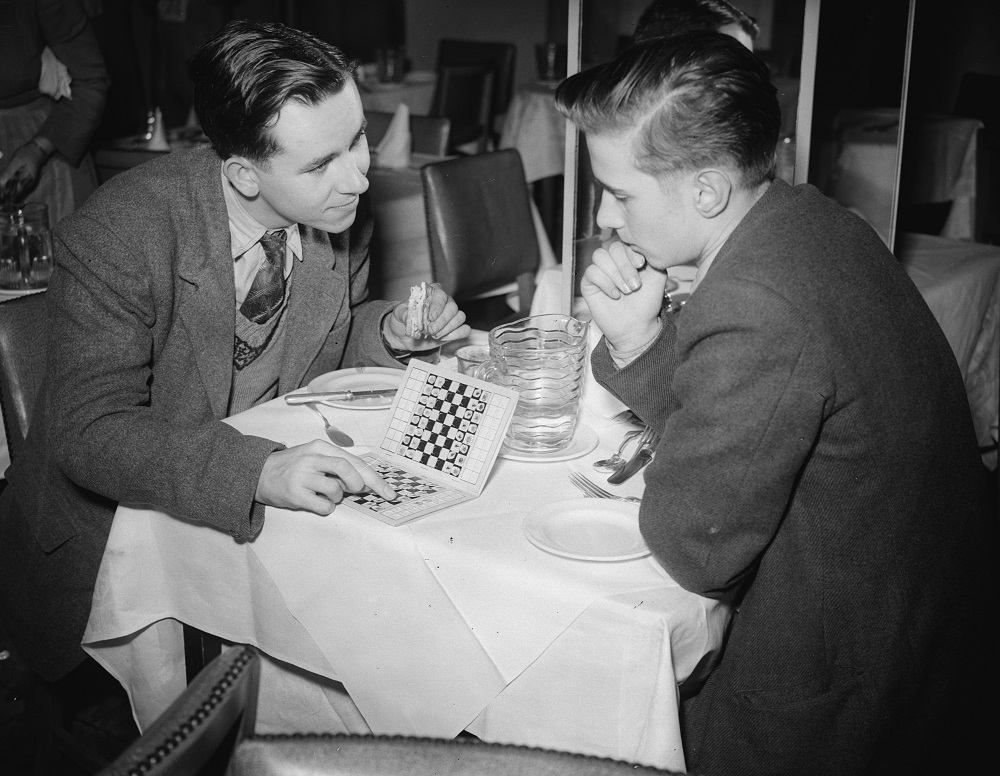
Edward Winter

Leonard Barden and Jonathan
Penrose
Permission for us to reproduce this photograph
from the Hulton Archive has been obtained by Olimpiu G. Urcan
(Singapore)
The present article brings together a range of C.N. items by and about Leonard Barden, an exceptional chess figure. As is evident from the quantity and quality of his contributions to C.N., our personal debt to him is enormous.
We are grateful to Leonard Barden (London), who has sent us the original game-scores from a simultaneous exhibition by Tal on 9 January 1964. Familiar names amongst the Blacks are Macdonald-Ross, Rumens and Hartston.
(1000)
See Mikhail Tal in London (1964).
A nomination made by Leonard Barden in 1967 for the best computer move:

This position, from a game between the Moscow Institute and Stanford University, appeared on page 187 of the June 1967 Chess Review. Barden’s view on White’s next move, 15 Rxh7, was quoted: ‘Undoubtedly the most brilliant move ever made by a computer’.
The Chess Review item, by J.S. Battell, ended:
‘We don’t know what brilliant moves may have been made by computers previously; but, in this game, the Moscow machine looms like a Morphy against a Duke of Brunswick and a Count Isouard. We do expect, however, that the future World Champion who takes on a computer will have a referee so stationed as to ensure against there being a Schlumberger behind the machine’s moves!’
(2234)
From Leonard Barden’s Foreword to the 1956 edition of The Elements of Chess by J. du Mont:
‘The quality of his prolific literary output made him undoubtedly the leading chess writer of his generation.’
(2757)
Some chess chroniclers are obliged to attempt, nolens volens, to sum up in a paragraph or two the complexities and uncertainties of the Termination of the first Karpov v Kasparov match (1984-85). We wonder whether readers can quote a better summary than the one on page 84 of the revised edition of Leonard Barden’s book Play Better Chess (London, 1987):
‘... Karpov began to sit on his lead, just waiting for Kasparov to make a fatal slip. But the match was now into its fourth and fifth month, and Karpov’s strength was ebbing. Kasparov got back to 5-1, then Karpov suddenly lost two games in a row for 5-3 after 48 games. The match was becoming an embarrassment to the Soviet authorities, and play was transferred from the grand Hall of Columns to the Hotel Sport in the suburbs.
After 48 games Florencio Campomanes, President of the International Chess Federation (FIDE), took his controversial and unprecedented decision to annul the match. He made his announcement at a chaotic Moscow press conference where both Karpov and Kasparov declared they wanted to continue to play. Campomanes then led the grandmasters backstage for private discussions after which he confirmed his decision. K and K blamed each other, the chess world was aghast at what was seen as an arbitrary and false conclusion which many thought was made to rescue a tottering Karpov. Objectively, however, it was still much more likely that Karpov would win one game before Kasparov won three, and the defending champion played under a psychological burden in the next K v K series in 1985.’
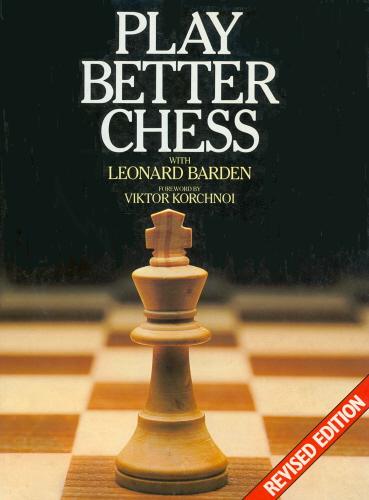
Our Termination article quotes an observation by Leonard Barden on page xviii of the Financial Times of 21 November 1987:
‘Central to Kasparov’s thesis is the “day of shame” when Campomanes abandoned the 1984-85 world title match just after the youthful hero had recovered from 1-5 down to 3-5. Karpov still needed only one win to complete the six required for the match. Kasparov’s account of this episode repeats his earlier public statements and seems to have it both ways. In one paragraph he says, “I wanted no part in any deals behind closed doors”. In the next, “the FIDE proposal to stop now and start afresh ... wasn’t so bad for me ... to start play again at nil-nil was better than 5-3 against”. It is a strange plot which, by its victim’s own assessment, doubled his chances of victory.’
The Australian magazine Chess World, July 1961 (page 158) reprinted from The Hindu an account by Leonard Barden of his interview with Fischer at Leipzig the previous autumn:
‘… I was astonished to discover how unorthodox his views were about the great chess masters of the past.
Lasker, considered by many the greatest chessplayer who ever lived, was dismissed by Bobby as “a weak player”. He told me he had played through the games of Alekhine but they were “nothing too interesting … he’d make some manoeuvres and then the other guy would fall for some combination”.
Among the world champions, Bobby had the greatest respect for Capablanca, whose games he had studied in some detail; but he’d also considered Chigorin, the man admired by the Russians, to be very interesting.’
A number of previous C.N. items have concerned Fischer’s article ‘The Ten Greatest Masters in History’ in the US magazine Chessworld, January-February 1964 (pages 56-61).
(2489)
See Fischer’s Views on Chess Masters.
Leonard Barden writes regarding William Winter:
‘I played Willie in the British championship in Buxton in 1950, and my strongest memory is that he showed himself a gentleman. I was in time-pressure with a lost position when he inadvertently allowed a threefold repetition. I claimed, he demurred, and as we waited for the arbiter I was overcome by guilt (I had learnt much from his Chess for Match Players) and confusion, and made a move. Then I realized again that I was right after all. Willie still agreed the draw even though I had invalidated my claim.
I never thought of Willie as “short”. Heights generally were lower then than now, but I guess he was about five feet five or six (1 metre 65-67). The group photograph taken at Nottingham, 1936 shows him looking very unhappy with his legs intertwined, but not appearing specially small.
William Winter
I did think Flohr (whom I also played, at Hastings, 1961-62) a small man, and believe his height may have helped him (less strain on the neck muscles) in large simuls, where he had a big reputation. I never saw Flohr give a simul, but witnessed Karpov twice ambushed by very strong teams of English juniors and thought that he too was helped by below-average height. In fact, Karpov was the best I ever saw in a large simul.’
We have now found a full-length picture of William Winter, taken during the Nottingham, 1946 tournament and given opposite page 49 in the book on the event published the same year by CHESS, Sutton Coldfield:
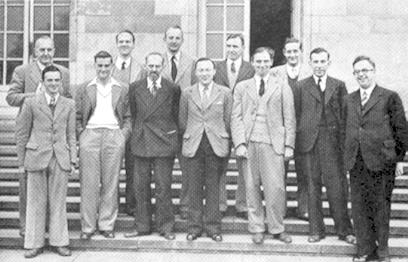
Front row, left to right: R.G.
Wade, F. Parr, W. Winter, R.F. Combe, C.H.O’D. Alexander, H.
Golombek, G. Abrahams
Behind: G. Wood, R.J. Broadbent, P.S. Milner-Barry, A.R.B.
Thomas, B.H. Wood
This was taken at the same place as one of the most famous chess group photographs: Nottingham, 1936.
An item in Chess Autographs:
Below is a page from one of our copies of Chess Secrets I Learned from the Masters by Edward Lasker (New York, 1951), inscribed by the players at Hastings, 1951-52 (plus Sämisch, a participant in the Premier Reserves tournament):
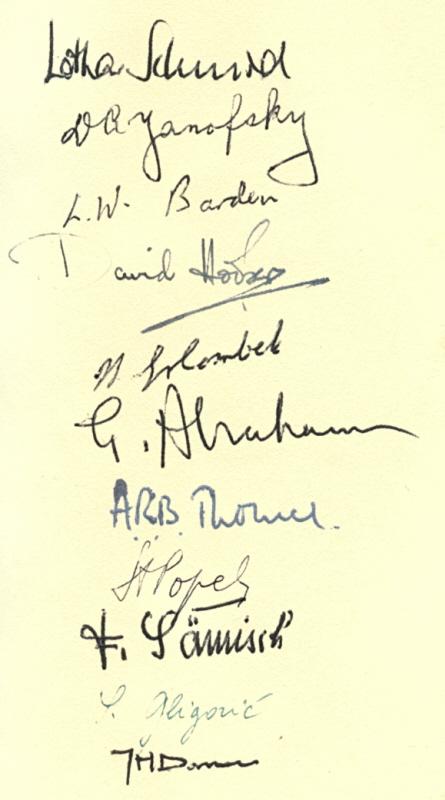
In order: L. Schmid, D. Yanofsky, L. Barden, D. Hooper, H. Golombek, G. Abrahams, A.R.B. Thomas, S. Popel, F. Sämisch, S. Gligorić and J.H. Donner.
What more is known about the ‘Smyslov Screw’ referred to by Stephen Fry (C.N. 4275)? Given that we recalled a 1970s Master Game television programme (BBC) in which the commentator, Leonard Barden, referred to Smyslov’s way of handling pieces (albeit deft captures in a single sweep, we thought, rather than screwing pieces into the board), we raised the matter with Mr Barden. He has replied as follows:
‘I’m sure I said it or wrote it in more than one place, and I was referring to the placing of Smyslov’s own piece as well as a capture of his opponent’s. I think many grandmasters have acquired the technique of a brusque swooping action when capturing. But my memory is that the original observation was made by Hugh Alexander, probably after his defeat by Smyslov in the Britain v Soviet Union match of summer 1954. Alexander also remarked on Botvinnik’s habit of writing his move down with careful precision, so that the opponent felt like resigning at move one. In 1960 I had the privilege of 14 blitz games with Robert Fischer when he visited my house. I lost 1½-12½, which I thought a good result for me, and was physically overawed, as were others, by Fischer’s large hands and talon-like capturing mannerism. So on more than one occasion, which doubtless included The Master Game, I brought these three cases together, with others, as examples of how lesser lights were subliminally intimidated by the greatest masters. I could well have said something like this, too, in the BBC Network Three radio chess programmes which antedated The Master Game by a decade. Later, of course, the technique moved to a more sophisticated level with Kasparov’s bombardment by thought waves ...’
As regards Botvinnik, the following passage from page 16 of C.H.O’D. Alexander’s A Book of Chess (London, 1973) is worth noting:
‘If you play Botvinnik, it is even alarming to see him write his move down. Slightly shortsighted, he stoops over his score sheet and devotes his entire attention to recording the move in the most beautifully clear script; one feels that an explosion would not distract him and that examined through a microscope not an irregularity would appear. When he wrote down 1...c2-c4 [sic] against me, I felt like resigning.’
We take the game in question to be Alexander v Botvinnik in the Amsterdam Olympiad of 1954, a Sicilian Defence.
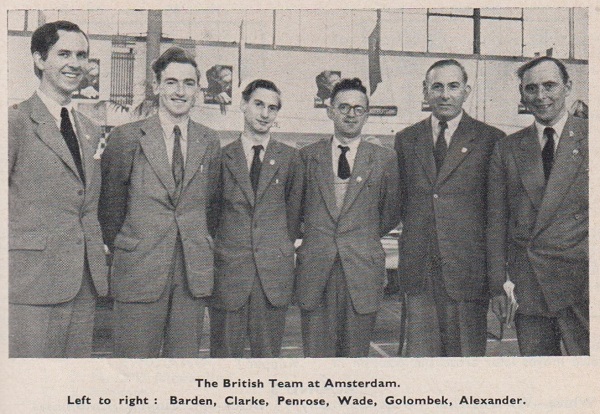
CHESS, 2 October 1954, page 37
In this shot (see Amsterdam, 1954: A Chess Photograph) Leonard Barden is number 14:
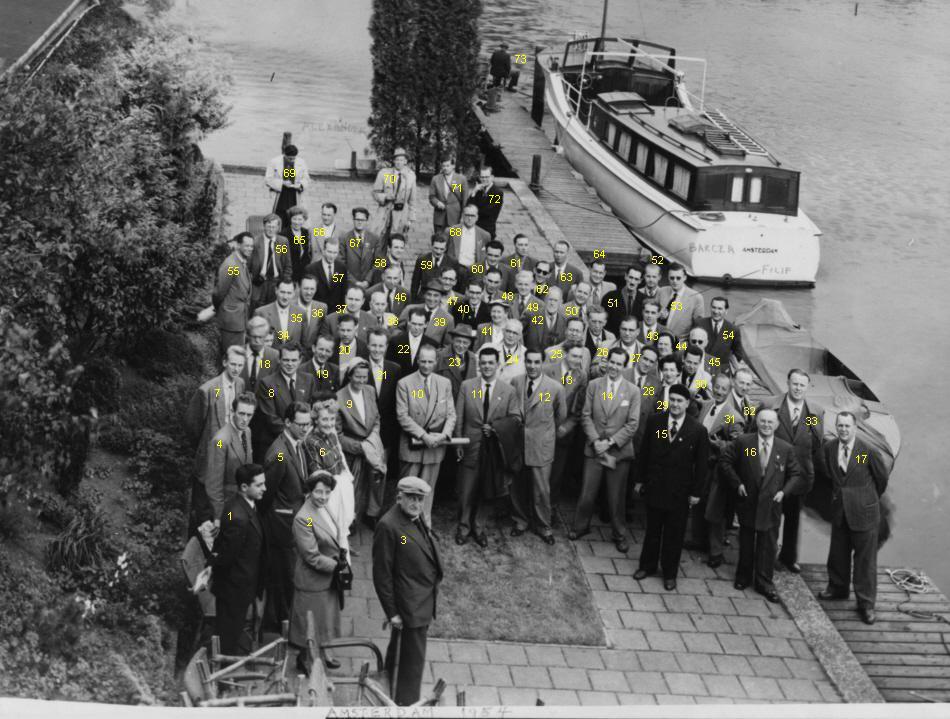
Leonard Barden has made a substantial contribution to our Mysteries at Sabadell, 1945 feature article.
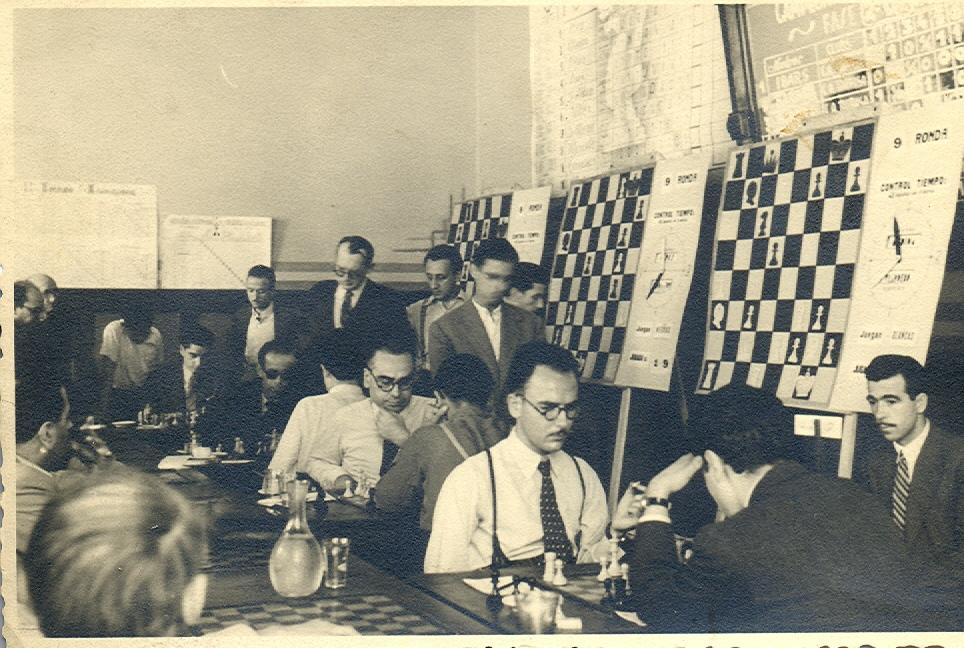
From Leonard Barden, with regard to C.N. 4442:
‘Although it is only incidentally relevant to John Donaldson’s query, I would mention that his reference to Frank Anderson as a gold medallist at the 1954 Olympiad needs qualification.
Amsterdam hosted the 1954 Olympiad at a few weeks’ notice when Buenos Aires, the scheduled venue, withdrew owing to financial irregularities within the Argentine Chess Federation. The Dutch organizers did a splendid job in the circumstances, but inevitably a few details were overlooked in the rush. So board prizes were forgotten until late in the day and, in at least some cases, were hastily-purchased mementoes. For his exceptional result on board two, Frank Anderson received a handled copper or pewter jug, about one foot high and with several dents.
He was one of the most likeable and pleasant chessplayers I have ever met. He went around on crutches, but made light of his disability. We became friends during that Olympiad, and, on his way back to Canada, he stopped over in London and visited my house. There he produced the jug and explained that he did not really care for it and that it would increase his excess luggage charge if he took it on the flight home. So he left it with me, and it resided on my mantelpiece for more than 30 years.
In the mid-1980s I heard that John G. Prentice of the Chess Federation of Canada planned to create a national chess museum of historical items. Prentice was a FIDE official and came to London for the 1986 world title match between Kasparov and Karpov. There I presented him with Anderson’s award. I recall that I was thrilled at my service to chess history, but that Prentice looked disappointed. He died the following year, and I still do not know if the museum ever took off or whether Frank Anderson’s board prize has survived. Perhaps one of your Canadian readers could provide some information.’
(4445)
David Cohen (Toronto, Canada), who runs the Canadian Chess website, informs us that no Canadian chess museum was ever created.
It has not yet been possible to determine what happened to Frank Anderson’s prize at the 1954 Olympiad.
(4468)
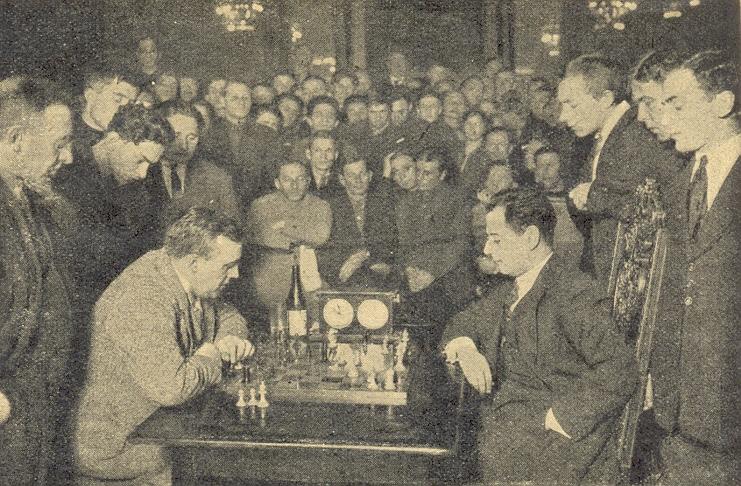
Leonard Barden writes regarding our feature article Analytical Disaccord and, in particular, the accompanying photograph (Capablanca v Bogoljubow, Moscow, 1925):
‘As there are no score-sheets and the players are not bothered by the public crowding around them, I imagine that the photograph is from the post mortem. It seems that the black queen is on e5, with white knights on c3 and h5. The central area around Black’s three rear ranks is particularly hard to make out, but it is possible that his king is on f7, with his knights on d7 and f6. If that is so, it would appear that the players were analysing the ...Qe5 alternative at Black’s 12th move but with, after 13 Nxg7+ Kf7, 14 Nh5 at once, rather than the more forcing and not hard to find 14 Rf5. That is odd, as it could imply that Capablanca had not seen the Rf5-f4 tempo-gaining trick during the game.’
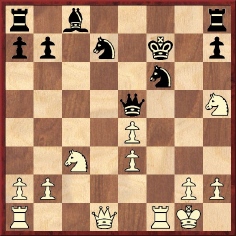
Variation after 12...Qe5 13 Nxg7+ Kf7 14 Nh5
Below is a close-up of the board:
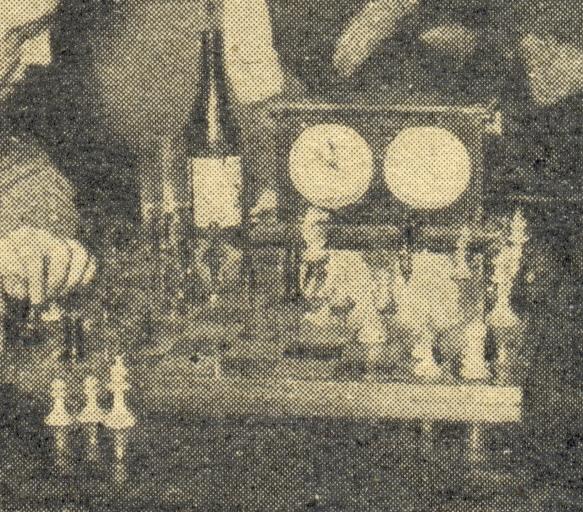
We gleaned the photograph from page 41 of Tartakower’s Shakhmatnaya pravda (Leningrad, 1926).
Regarding our feature article on Sultan Khan Leonard Barden comments on the following passage quoted by us from page 215 of The Guinness Book of Chess Grandmasters by W. Hartston (Enfield, 1996):
‘Eighteen years later, however, [i.e. in 1951] when he [Sultan Khan] was shown the moves of the games in the world championship match between Botvinnik and Bronstein, he is reputed to have dismissed them as the games of two very weak players.’
After mentioning that the source of this reputed dismissal was unknown to us, we also quoted William Winter in CHESS, February 1963, page 148:
‘I remember vividly my first meeting with the dark-skinned man who spoke very little English and answered remarks that he did not understand with a sweet and gentle smile. One of the Alekhine v Bogoljubow matches was in [a] progress and I showed him a short game, without telling him the contestants. “I tink”, he said, “that they both very weak players.” This was not conceit on his part. The vigorous style of the world championship contenders leading to rapid contact and a quick decision in the middle game was quite foreign to his conception of the Indian game in which the pawn moves only one square at a time.’
Leonard Barden informs us:
‘Hartston’s story about Botvinnik-Bronstein had appeared in one of my columns. My own source was the Pakistani A. Kitchlew, a strong player who competed in the Hastings Challengers’ tournament in the 1950s and 1960s and a few years ago won a lower section at Jersey when in his eighties. Kitchlew and I both played for the Linguists Club of Kensington, London, team in the National Club Championship around 1956, and he then told me that he knew Sultan Khan and that Sultan had indeed made the comment I quoted. I had and have no reason to believe he was embellishing the tale.
It seems quite a reasonable remark from a world-class player about the 1951 match, where the quality was uneven.’
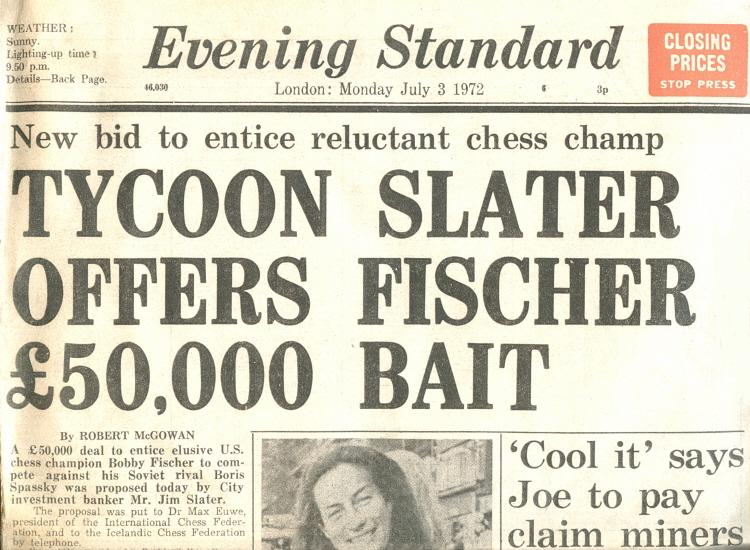
For Leonard Barden’s account of the episode, see pages 26-27 of CHESS, November 1997.
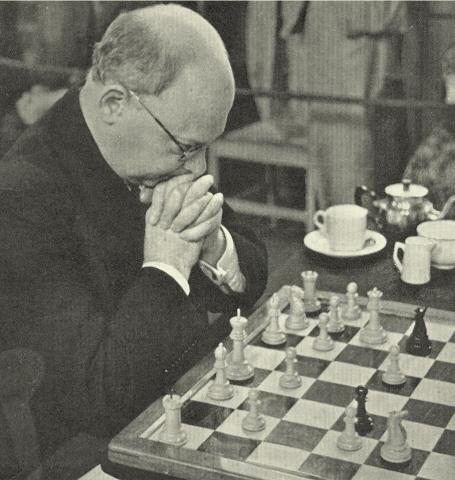
Savielly Tartakower
From Leonard Barden:
‘Tartakower played me in his Free French uniform and, a decade later, we met in the Cercle Caïssa in Montmartre.
The first occasion was in early 1945 when I visited Julius du Mont’s house and found the doctor there discussing 500 Master Games of Chess. I was already helping du Mont with checking proofs for the BCM and his columns and books, so he gave me some work while they finished their talk and then persuaded Tartakower to play me. He was the first world-class grandmaster I ever met, an imposing figure in the uniform. There were no clocks. He was Black in a Dutch Defence. He sortied his queen to a5, then blocked its retreat, allowing me to trap it in elementary fashion by b4. He resigned promptly, and suggested a second game. I had been reading My System so tried the Nimzowitsch Sicilian with an early d5, but was swiftly outplayed. I did not take a game-score.
In July 1955 I visited Paris, was told of the Caïssa café so went to the Boulevard Montmartre hoping to play for stakes and help finance my trip. There were around a dozen to 20 patrons each afternoon, presided over by a charming elderly lady, Madame Le Bey Taillis. My hopes of unsuspecting victims were soon dashed as Madame found out that I was British champion and introduced me gushingly as such to prospective opponents. So most days I ended up playing five-minute games with the café professional Sherbakov, who competed in one or two minor international tournaments of the time. We were evenly matched, and after several hours there were only a few centimes in it.
Tartakower used to visit daily and play almost exclusively with an old gentleman to whom he gave odds (I forget whether a knight or substantial time-odds). The amateur was accommodating, lost virtually every game, and paid up after two or three hours. One afternoon the doctor was late and the old gentleman was en prise, so I took the opportunity to become his opponent and to collect from him. After an hour or so Tartakower arrived and looked aghast at what was probably his rent and roulette money being usurped. He sat down on the same side of the table as the amateur and fixed me with a cold stare. I soon took the hint and gave way.
We left the café together later that evening and it seemed that Tartakower had not fully forgiven me. He was too polite to reproach me directly, but began a gentle probe. My French was poor, but he rarely uttered English words. “You have been an undergraduate. What did you study?” “History, doctor.” “Ah good, can you help me with a historical question?” “I’ll try.” “In what year was the Battle of Hastings?” “1066.” “Bravo, felicitations!” It was well-known that the doctor liked to use this last phrase sarcastically to people he thought had overstepped the mark. We said our farewells, I left for London the next day, and seven months later wrote a sympathetic obituary for the Guardian.’
(5226)
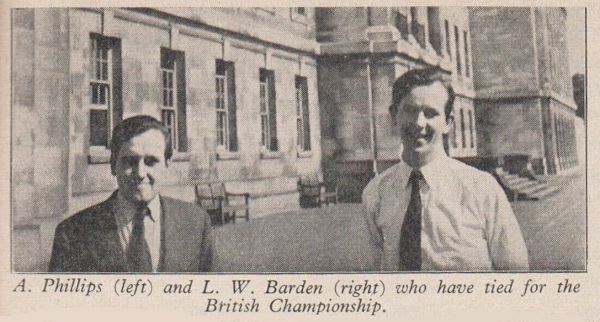
CHESS, September 1954, page 3
C.N. 5460 commented that a surprising number of newspapers and chess magazines had handled Fischer’s death in pedestrian fashion, and that one of the best obituaries was by Leonard Barden in the Guardian of 19 January 2008.
Page vii of One Move and You’re Dead by Erwin Brecher and Leonard Barden (London, 2007) records that Barden ...
‘... was the first to predict in print that Garry Kasparov (then 11) would become world champion and that Nigel Short (then nine) would become Kasparov’s challenger.’
Regarding the Kasparov forecast, we are grateful to the Guardian Research Department for sending us the column in question (Guardian, 24 February 1975, page 16) and for permission to reproduce it here:
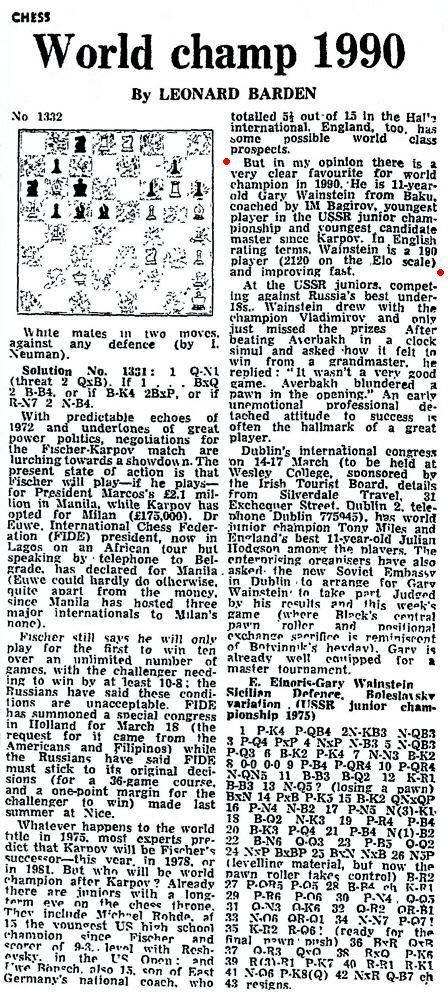
‘But in my opinion there is a very clear favourite for world champion in 1990. He is 11-year-old Gary Wainstein from Baku, coached by IM Bagirov, youngest player in the USSR junior championship and youngest candidate master since Karpov. In English rating terms, Wainstein is a 190 player (2120 on the Elo scale) and improving fast.’
In C.N. 507, after the prediction’s appearance on pages 5-6 of the book on Kasparov Fighting Chess (London, 1983), we described it as ‘an amazing piece of talent-spotting’. Fighting Chess called the passage ‘the first western report’ on Kasparov.
Further to the remarks about English players in the above Guardian column, Mr Barden informs us:
‘My comment that “England, too, has some possible world class prospects” was a reference to both Julian Hodgson and Nigel Short. It was not until March-April 1975, after Short had performed impressively in Jersey and in a junior event in London, that I rated him ahead of Hodgson, allowing for age, and as a potential rival for Garry Kasparov. At the end of the London event I asked Čenĕk Kottnauer, whose opinion on juniors I regarded highly, to analyse and play a game with Short, and Kottnauer was greatly impressed.
The invitation to the Soviet Embassy for Weinstein to play was on my prompting, my grounds being that he would be nervous on his first journey to the West and that Hodgson could gain a psychological edge for battles to come. Moscow refused.
My forecast in the Guardian of 24 February 1975 was made about 15 months before Botvinnik went into print with his famous remark about the future of chess being in Kasparov’s hands.’
Addition on 9 May 2025:
From the Guardian chess column by Leonard Barden, 9 May 2025:
At international level, the boy to watch is Roman Shogdzhiev. The Russian, already world under-eight champion with 11/11 and world under-10 champion with 10/11, achieved his first IM norm last year aged nine, and has just scored his second IM norm at the Baku Open, registering a tournament performance of over 2500. Shogdzhiev is now on track to break the record of Argentina’s “chess Messi” Faustino Oro as the youngest ever international master.
The Garry Kasparov of the 21st century? In 1975, this column forecast that the then unknown 11-year-old Garik Weinstein (later Kasparov) would succeed Anatoly Karpov as world champion by 1990. Now, Shogdzhiev looks the part as the player to restore Russia’s lost chess glories in the next decade.
From Leonard Barden, who was a participant in the tournament in question (Hastings, 1957-58), in reply to C.N. 6092:
‘I have the impression that Fischer withdrew in late October, which, allowing for magazine production time, would be consistent with the Chess Life and BCM reports. Given that FIDE had a four-year cycle and that Fischer obviously had a chance to qualify for the Interzonal, I do not think that any other decision by him was possible. Frank Rhoden, the Hastings organizer, was philosophical about it, and hoped to include Fischer another year. A couple of weeks before the start of the tournament, Rossolimo also withdrew, giving an opportunity to me.’
We add that the top finishers at Hastings, 1957-58 were: 1st P. Keres; 2nd S. Gligorić; 3rd M. Filip; 4th L. Barden.
(6097)
Leonard Barden informs us that his daily (Monday-Friday) chess column in the London Evening Standard began in early June 1956. Apart from one week in May 2009 when it appeared on-line only, the column continued in the newspaper until 30 July 2010. Since then, it has been published exclusively on-line.
Has there ever been, in any journalistic field, such a run for a daily column by a single individual?
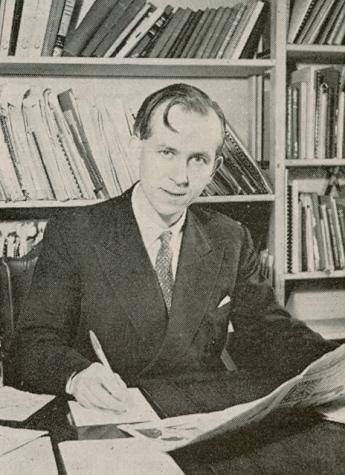
Leonard Barden (Chess Life, August 1962, page 169)
In C.N. 6712 Leonard Barden notified us that his daily (Monday-Friday) chess column in the London Evening Standard began in early June 1956 and that (apart from one week in May 2009 when it appeared on-line only) it continued in the newspaper until 30 July 2010. Since then, it has been published exclusively on-line. That C.N. item asked whether there had ever been, in any journalistic field, such a run for a daily column by a single individual; no competing claims were received.
Now, however, we learn that although Leonard Barden had hoped to continue until at least June 2016, completing a 60-year run, the newspaper intends to terminate the column at the end of December 2014.
(8979)
Further to C.N. 8979, Mr Barden tells us that the Evening Standard has now agreed to prolong his chess column for a month, until the end of January 2015, to give time for a longer-term solution to be sought.
(9022)
Further to C.N.s 8979 and 9022, Mr Barden informs us that he has now agreed terms with the Evening Standard for his on-line column to continue.
(9041)
Leonard Barden informs us:
‘The daily chess column in the Evening Standard will finally reach its end on Friday, 31 January 2020. I have given the starting-date as Monday, 4 June 1956 since although I am not totally sure of the exact date I recall that it was early June and some time after Whitsun, which was in May that year. The total is thus 63 years, 7 months and 27 days without a day missed. The final puzzle is a Carlsen win from the 2019 world blitz championship.’
(11695)
Addition on 31 January 2020: the final chess column in the Evening Standard is reproduced below, with permission:
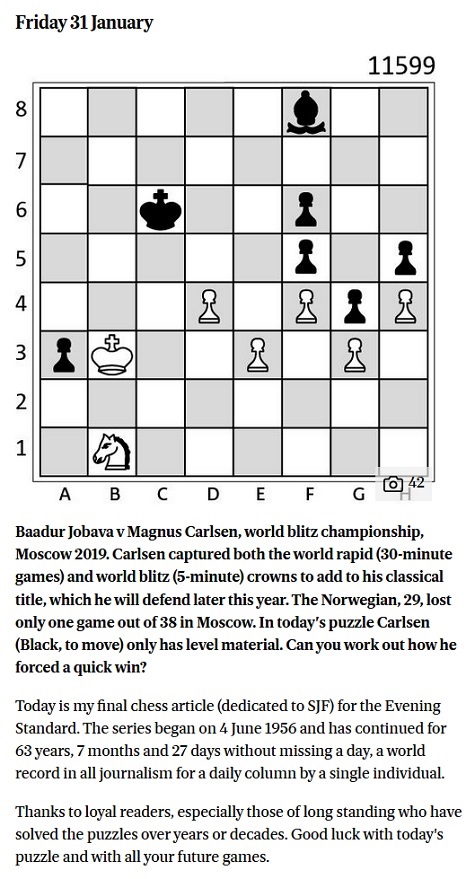
See too Chess Records.
From Leonard Barden (writing in response to C.N.s 6930 and 6983):
‘I witnessed Tartakower making notes during at least one game, at one or more of the Southsea tournaments of 1949, 1950 and 1951, where we both participated. His game against Ravn at Southsea, 1951, which is in his Best Games collection, sticks in my mind.
On one occasion I was curious enough to creep up behind him to see exactly what he was doing. There was a dense sheet of variations and quite small writing, and I think he had some difficulty in reading his own material, pushing his spectacles back on his forehead, screwing up his eyes, and peering closely. I feel fairly sure that nobody objected. He was a legend, and the rules on consulting written material during play were more relaxed then than now.’
Leonard Barden writes (further to C.N. 7160, on Franklin Russell):
‘In the mid-1970s I reported on that year’s Oxford v Cambridge match in my column in The Field. I received a letter from Franklin Russell, who told me of his participation in 1912-14. Cambridge could award half-blues but Oxford could not, so Russell’s team made an unsuccessful application to the Oxford Blues Committee. He asked if the situation had changed since he played, and I had to tell him that there had been several such applications over the years, but all had been rejected.
He then told me that the Oxford players of his time had created a special award of “representative colours” for their team along with a multi-coloured tie which the team wore at the match. He was keen that this initiative should be revived, and sent the Oxford team for the next year’s match a batch of seven ties, asking that they be worn. He also sent a tie, which I no longer possess, to me. Alas for his enterprise, by the mid-1970s dress attitudes were becoming more casual and only two or three of the Oxford team wore the Russell tie at the match.’
Page 152 of the April 1914 BCM stated:
‘The Oxford team has been largely made what it is by the influence and example of Mr Russell, whose loss will be greatly felt when he returns to his native air ...’
He returned home to the United States on 4 July 1914 (American Chess Bulletin, September 1914, page 205).
From Leonard Barden (in response to C.N. 7295):
‘Bob Wade did indeed believe that he would be credited on the title page as the editor of Modern Chess Openings, as he told me several times, including in 1949 when he enlisted me to write a section on the Queen’s Gambit Declined. He claimed to have done the great majority of the work entailed in the book’s revision.
He was angry at what he perceived as Korn’s diminishing of his contribution when Modern Chess Openings appeared, and vowed that he would never work with Korn again.’
Leonard Barden writes:
‘The mild tone of Bob Wade’s August 1952 letter to CHESS which you reproduced in C.N. 7300 suggests that he had not completely given up on Walter Korn by then and that his hostility grew later.
Korn asked me to be the reviser for the tenth edition of Modern Chess Openings in 1962 or 1963, for a flat fee of about £1,000. Conscious of what Wade had told me, I haggled and asked for firm payment guarantees. The negotiations broke down, and Korn turned to Larry Evans. I should add that as an active grandmaster he did a better job than I, as a pure theoretician, would have done.
At the time when Korn was appointed editor of Modern Chess Openings, there was a widespread feeling among leading players and writers that his credentials (a few theoretical articles in the BCM) did not justify his acquiring the rights to Modern Chess Openings from the ageing Richard Griffith.’
From page 190 of the April 1973 Chess Life & Review:
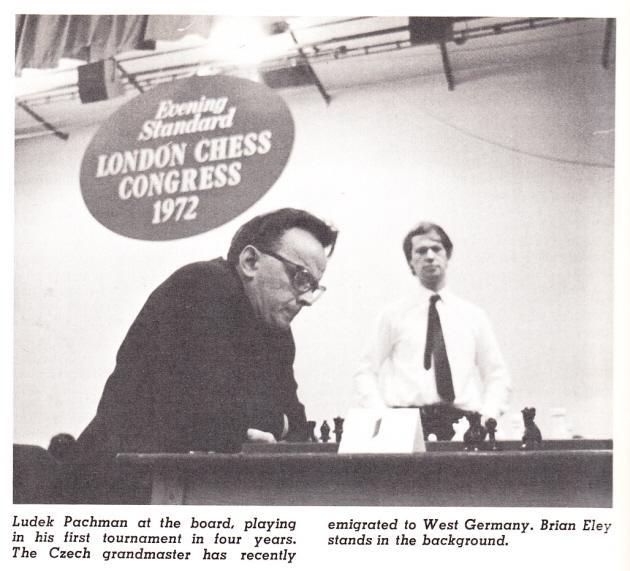
The magazine stated that the photograph was taken after Pachman had played 14...b5. Eley won the game in 24 moves and annotated it on pages 266-268 of the June 1973 BCM.
(7663)
Leonard Barden writes:
‘Pachman played at the Evening Standard tournament in Islington, London in 1972 on my initiative. The Standard naturally wanted a personality to channel publicity for the Open, and news of Pachman’s release from prison and emigration to West Germany came a few weeks before the tournament. I had got on well with him when we met at Olympiads and, even earlier, at Southsea, 1949, and I also knew Wolfgang Unzicker, at whose home in Munich he stayed after his release. The Standard was willing to pay for his trip to London, so he agreed to compete.
While in prison Pachman had sent an emotional rallying call to chessplayers which was published on page 351 of the October 1968 Chess Life. At the end of the opening ceremony at London, 1972 I read out this message to the players, after which Pachman entered the hall and walked, applauded, to the stage. As I recollect, many of my audience looked fidgety, obviously not very interested and evidently keen for the first round to start.
We wanted him to have an interesting first-round opponent, so Stewart Reuben adjusted the draw slightly so that Pachman was paired with Jonathan Speelman, then aged 16. Pachman won. Of course, he was not technically or psychologically prepared for a weekend tournament with three rounds on the Saturday, so it was no great surprise that the next day Brian Eley caught him in the “DERLD”, which was then a much analysed opening in England.
I was at that time the chess adviser to Faber and Faber, whose director, Charles Monteith, had a celebrated record for spotting and publishing winners – which had included Waiting for Godot and Look Back in Anger. Faber and Faber had a mutual arrangement with Simon & Schuster and was offered the British rights (for a low figure) to Fischer’s My 60 Memorable Games, which Monteith took up on my enthusiastic recommendation.
So when I knew Pachman was coming and that he had announced that he was preparing his memoirs, I told Monteith. Another publisher was also in the hunt. When Pachman arrived at Heathrow Airport there were flowers to greet him from the rival publisher, but Monteith was there with a contract ready for signature. “Flowers good, contract better”, said Pachman. The memoirs, Checkmate in Prague, were published by Faber and Faber in 1975 but, alas, were written in a rather turgid style and were a marketing flop.
Clement Freud was invited to award the prizes at the 1972 Evening Standard congress because Stewart Reuben had read Freud’s articles on the Spassky v Fischer match; he was suitable as the high-profile personality we wanted to justify the Standard’s backing.
As well as money, offered without my asking for it by the legendary editor Charles Wintour, the Standard provided daily advance mentions of the forthcoming congress, which, added to the Fischer boom effects, brought about the then world record entry (a total of 1,208 entrants for the five events).’
C.N. 6081 reproduced this photograph from page 121 of CHESS, January 1973:
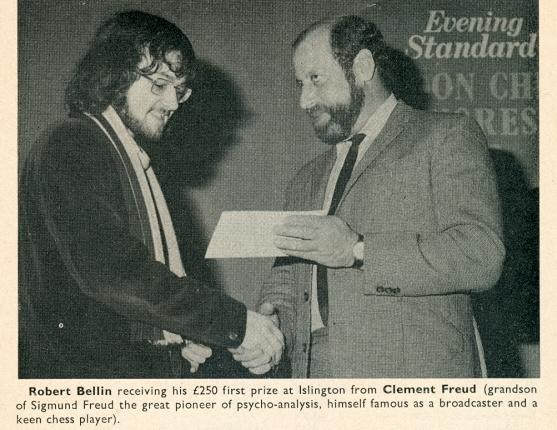
Leonard Barden recently raised with us the subject of Vera Menchik’s death, asking, in particular, whether references could be found to her burial or cremation. We are grateful to Olimpiu G. Urcan for making a search which revealed this record in the Andrews Index:
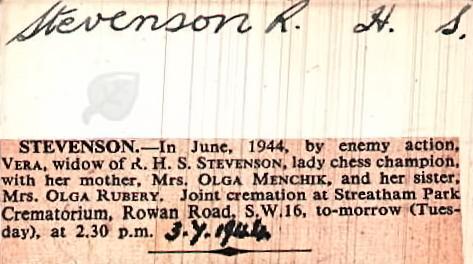
On the basis of the above information Mr Barden then informed us:
‘I contacted the Streatham Park Crematorium, which confirmed that Vera Menchik Stevenson, her mother and her sister were cremated on 4 July 1944 and that their ashes were scattered at a garden of remembrance, whose reference location is known. Whether that is precise enough for a memorial to be considered is arguable. Their house in Gauden Road, London was destroyed, and the policy of English Heritage, even if it could be interested, is to put plaques only where the original building still stands.’
Peter Morris (Kallista, Australia) draws attention to two books which discuss Alexander v Reshevsky, Nottingham, 1936:
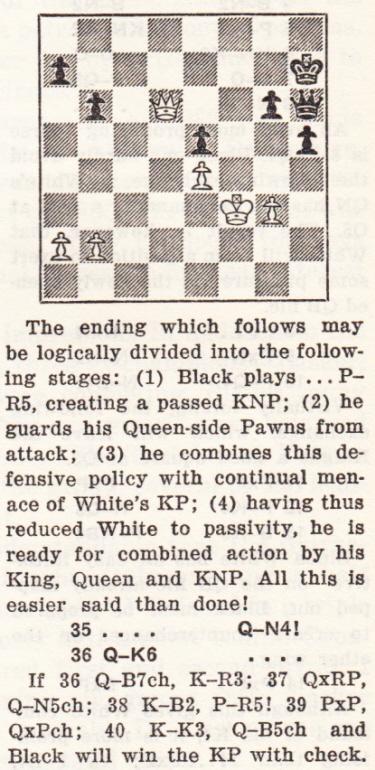
Page 80 of Reshevsky on Chess by S. Reshevsky (New York, 1948)
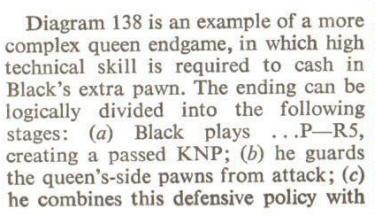
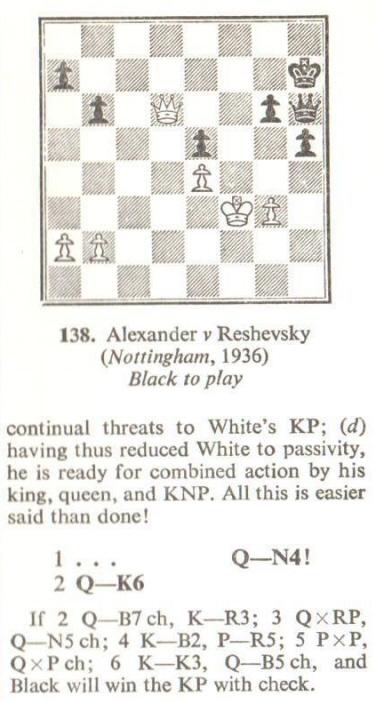
Page 84 of How to Play the Endgame in Chess by L. Barden (London and Glasgow, 1975)
We have raised the matter with Leonard Barden, who responds:
‘The great majority of my writing was and is solely by me, but I had a collaborator for the Collins book who wrote some chapters and supplied some material, though I personally checked the whole book in proof.
At nearly 40 years’ distance I cannot recall or decide which of us was responsible for Alexander-Reshevsky. In either case I would have expected at least some rephrasing, as occurs in the other notes quoted, so I now think that the neglect to do this was simple human error.
I should add that I find it completely convincing that Reinfeld wrote the Reshevsky book and thus the paragraph in question. When Reshevsky really wrote his own notes, as he did in some late material in Chess Life, the style was terse and arid, in contrast to Reinfeld’s lucid and informative explanations.’
See too Chess
and Ghostwriting.
In his Financial Times column of 30 August 1986, Leonard Barden states that this was the position after Black’s 33rd move in Winter-Capablanca, Nottingham, 1936:
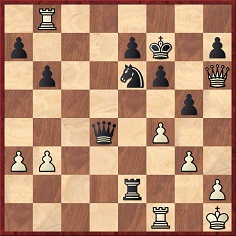
‘Several readers spotted that 1 Q-R5ch wins a rook. Not a misprint – Capablanca’s previous move was R-K7 [from e4] and Alekhine makes no comment in the tournament book. Thus a blunder by two world champions is found some 50 years later.’
In fact, the tournament book inverted Black’s 33rd and 34th moves – there was no opportunity to win a rook. Play went 33...Ng7 34 Qxh7 Re2.
(1252)
C.N. 8148 gave a loss by Čenĕk Kottnauer in a simultaneous display in Rapperswil, Switzerland on 31 January 1953. Earlier that month he won a tournament in Lucerne, and Leonard Barden, who was also a participant, informs us:
‘Čenĕk Kottnauer used that event to announce that he was seeking asylum in the West. He had been in the Czechoslovakian sports ministry and believed that there was an attempt by Karel Opočenský, who wanted his job, to link him to the Rudolf Slánský group. Kottnauer’s wife Danielle joined him in Lucerne after being smuggled out of Prague in the boot of a diplomatic car. Kottnauer and I became good friends, and I was still visiting him for blitz sessions 30 years later.
I gave further details at the English Chess Forum on 25 January 2009.’
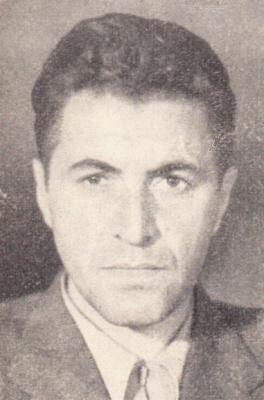
Čenĕk Kottnauer (Schweizerische Schachzeitung, January 1953, page 1)
With regard to the Lucerne, 1952-53 tournament, the FatBase database ascribes to Leonard Barden a short lost against Marcel Post of Lausanne (1 e4 c5 2 Nf3 d6 3 d4 cxd4 4 Nxd4 Nf6 5 Qd3 g6 6 g3 Bg7 7 c3 Nbd7 8 Bg2 O-O 9 O-O a6 10 b3 Qc7 11 Bb2 b5 12 Nd2 Bb7 13 Rac1 Ng4 14 c4 b4 15 Qe2 Ndf6 16 Nc2 Qa5 17 a3 bxa3 18 Bc3 Qxc3 19 White resigns), but that was Kottnauer’s win against Post (played on 3 January 1953 and published in the Neue Berner Zeitung, 31 January 1953).
On 30 December 1952 Leonard Barden won against Post (1 e4 e5 2 Nf3 Nc6 3 Bb5 a6 4 Ba4 d6 5 Bxc6+ bxc6 6 d4 f6 7 c4 g6 8 Nc3 Nh6 9 dxe5 fxe5 10 Bg5 Qd7 11 Bf6 Bg7 12 Nxe5 Resigns), as recorded in his tournament report on page 90 of the February 1953 CHESS:
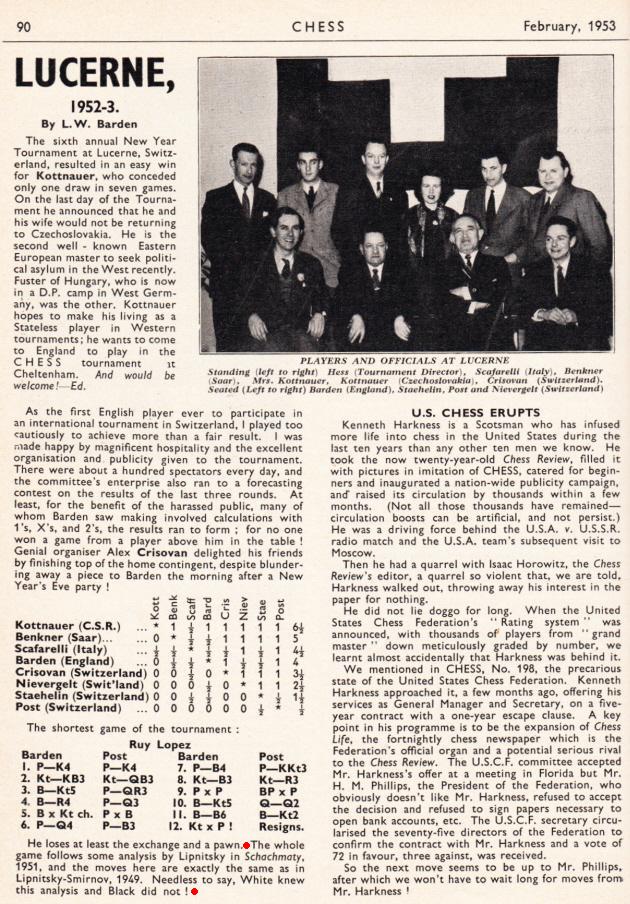
When Post annotated his defeat on page 4 of the January 1953 Schweizerische Schachzeitung he showed no awareness of the precedents highlighted above:
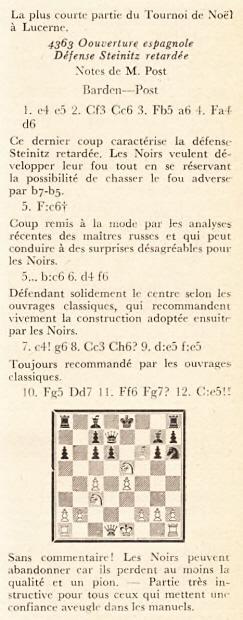
Can readers provide details regarding the Lipnitsky game and analysis?
Two follow-up items were C.N. 8176 and 8181.
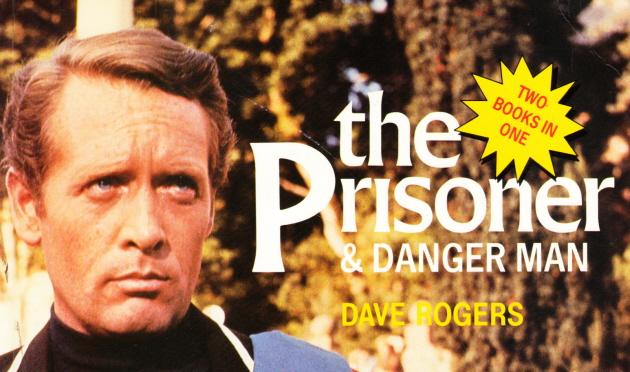
C.N.s 8143, 8146 and 8150 discussed the episode ‘Checkmate’ in the 1967 television series The Prisoner, in which Patrick McGoohan wrote on a chess diagram in a newspaper:
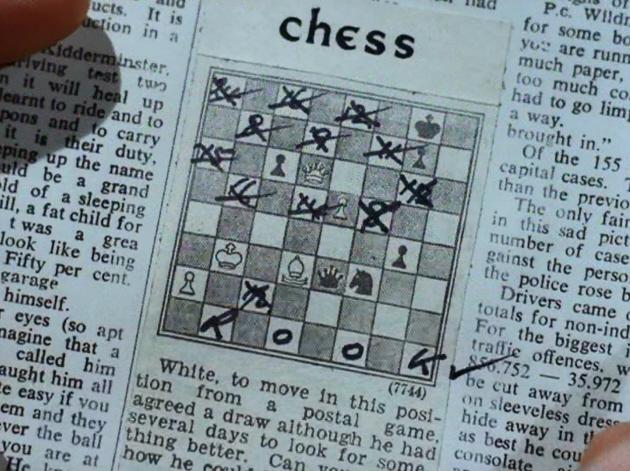
The column was recognizable as Leonard Barden’s in the London Evening Standard, and it was subsequently established that the position was from a correspondence game (Niels Lie v Arne Desler) played in the early 1930s.
The remaining loose end has been the date of publication in the Evening Standard, and we can now report that the position appeared on page 4 of the 9 January 1967 edition, with the solution given on page 8:
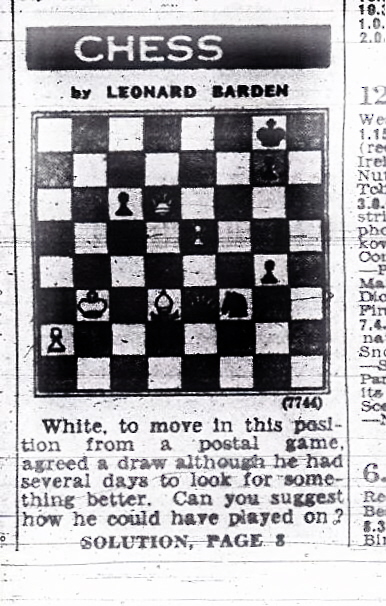
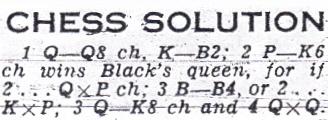
See too Chess and The Prisoner.
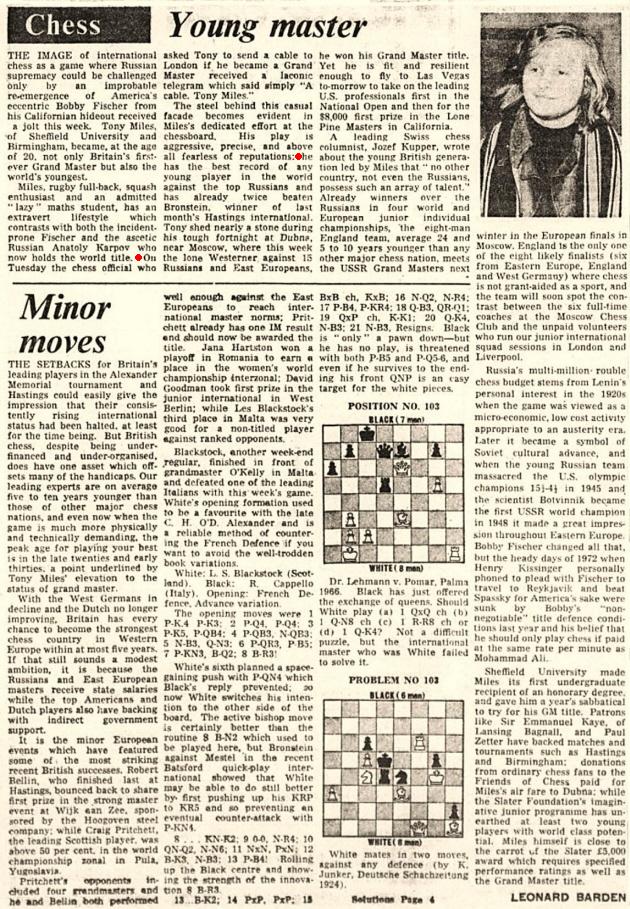
Financial Times, 28 February 1976, page 8
Quite by chance we have just discovered the following:
‘On Tuesday the chess official who asked Tony to send a cable to London if he became a Grand Master received a laconic telegram which said simply “A cable. Tony Miles.”
The steel behind this casual facade becomes evident in Miles’s dedicated effort at the chessboard. His play is aggressive, precise, and above all fearless of reputations ...’
‘A British chess federation official who had asked Miles to send a cable to London if he ever became a Grandmaster received a laconic telegram which simply read “A cable. Tony Miles”. The steel behind this casual facade becomes evident in Miles’ dedicated effort at the board – aggressive, precise, and above all fearless of reputations.’
‘A British Chess Federation official who had asked Miles to send a cable to London if he ever became a Grandmaster received a laconic telegram which simply read “A cable. Tony Miles”.
The steel behind this casual facade becomes evident in Miles’ dedicated effort at the board – aggressive, precise, and above all fearless of reputations.’
Page 6 of The English Chess Explosion stated, ‘we would like to thank Leonard Barden for permission to quote from his articles in The Guardian and The Financial Times’. The above, of course, is not a case of ‘quotation’.
The ‘cable’ message written by Tony Miles was discussed in C.N.s 8248 and 8253.
A section from our feature article Cuttings:
Raymond Keene’s book on the 1993 Kasparov v Short match was reviewed by Leonard Barden on page A56 of the Guardian, 20 November 1993. Barden criticized the ‘hype’, as well as ‘much gloating’ about the financial problems of the rival Karpov v Timman match.
On page 68 of the Spectator, 27 November 1993 Raymond Keene ignored the book critique and picked out just two words of Barden’s: the statement, perfectly true in its context, that the Karpov v Timman match had been ‘completed normally’. Professing to be amazed by this remark, Keene wrote:
‘On what planet are these people living?’
As regards the planet on which Raymond Keene was living, the day when the ‘Professional Chess Association’ was set up, 24 February 1993, was ‘one of the best days of my life. This is fantastic. ... It will go down in history this day.’
Source: transcript of a telephone conversation between Keene and Kasparov on page 17 of the above-mentioned Kasparov v Short match book. The heading on page 15 was: ‘An Historic Conversation.’
Page 3 of Kasparov v Short (Moscow, 1993) stated regarding the Professional Chess Association, ‘this body was grounded in May 1993’.
As documented in C.N. 5375, Kasparov later described his decision to break away from FIDE as ‘a terrible blunder, the worst of my career’.
From Leonard Barden:
‘In an interview after his match against Anand, Carlsen said that he had no on-site seconds in Chennai, although he was in contact via Skype with Jon Ludwig Hammer, Norway’s number two player.
When was the last time that a player had no strong assistant at a world championship match? I am referring to assistants of master level capable of providing technical help, and not “seconds” who were effectively managers dealing with match rules and similar matters.’
Precise records of players’ seconds are often difficult to trace, and no list of the kind requested by a correspondent in C.N. 5657 has yet been built up. For example, for the 1929 and 1934 Alekhine-Bogoljubow matches and, even, the 1927 Capablanca v Alekhine encounter it seems unclear which other players were involved in any capacity.
In response to Mr Barden’s enquiry we can offer a quote from page 135 of the June 1962 Chess Life (the item mentioned in C.N. 8399). An interviewer asked Botvinnik:
‘Why did you decide against having a second in the return match with Tal?’
Botvinnik’s response:
‘My friend, the master Goldberg, with whom I have worked these past years, refused to be my second this time. He is older than I, and to second is far more tiring than to play. It is exhausting, and I understand his point of view. For example, when I help as a spectator at a chess tourney, I tire faster than if I play myself. And the second has to be alert for the five-hour duration of the game, as well as afterwards, to analyze the adjourned game throughout the night. So before me rose the question: “Should I engage a new second whom I may not have too much confidence in?” How could we successfully work together without a long friendship and mutual respect? Therefore, I decided not to use a second.
Formerly, when I was young, I always played alone. I decided to take the risk and, as you see, it didn’t turn out badly. It is true that in some games I had difficulties because of poor analysis; I made bad mistakes of analysis in the second and 19th games.’
From page 71 of The World Chess Championship 1963 by R.G. Wade (London, 1963):
‘Each player was entitled to have a “second” to help in openings, preparations and adjournment analysis. Surprisingly Botvinnik had no-one. Petrosian had the benefit of aid from the very capable grandmaster Igor [sic] Boleslavsky. A second, who is temperamentally suited, can make a very appreciable difference. Botvinnik showed the need in the decisive 18th game, where his adjournment homework was not up to his usual standard.’
On page 129 of the May 1963 BCM Harry Golombek, who was the judge in Moscow, wrote of Botvinnik:
‘He has no official second here whereas Petrosian has the redoubtable Boleslavsky as his second.’
Other quotes on this topic will be gratefully received.
See too Chess Seconds.
Alan McGowan (Waterloo, Canada) draws attention to a photograph on page 36 of the 1-2/1953 issue of FIDE Revue:
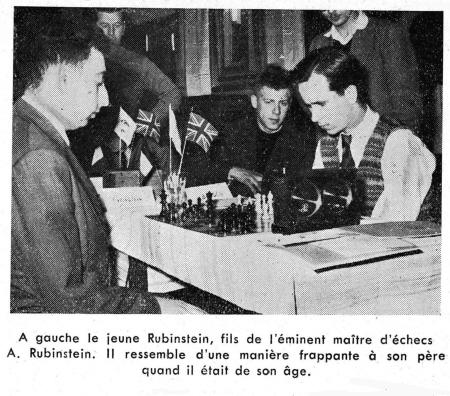
Two photographs from the plate section of the June 1953 BCM (between pages 162 and 163):
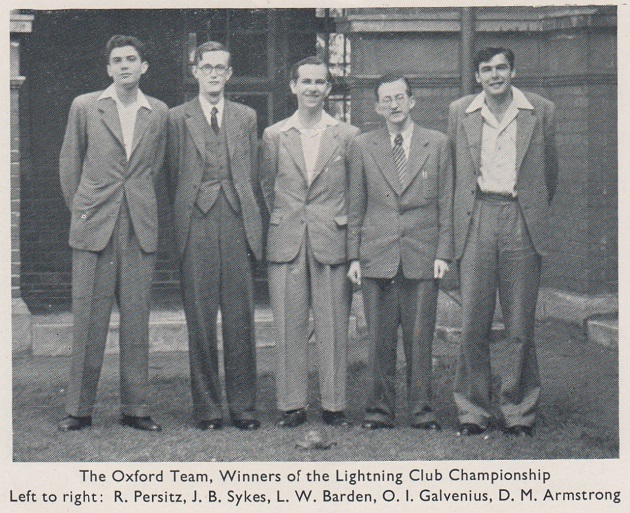
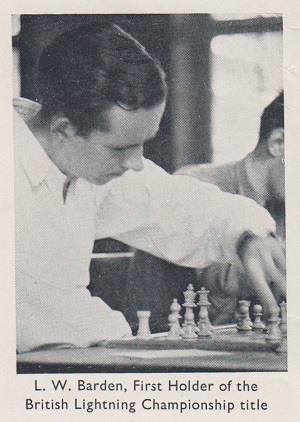
A report about the Gambit Chess Rooms, London on pages 23-25 of Picture Post, 12 January 1946:
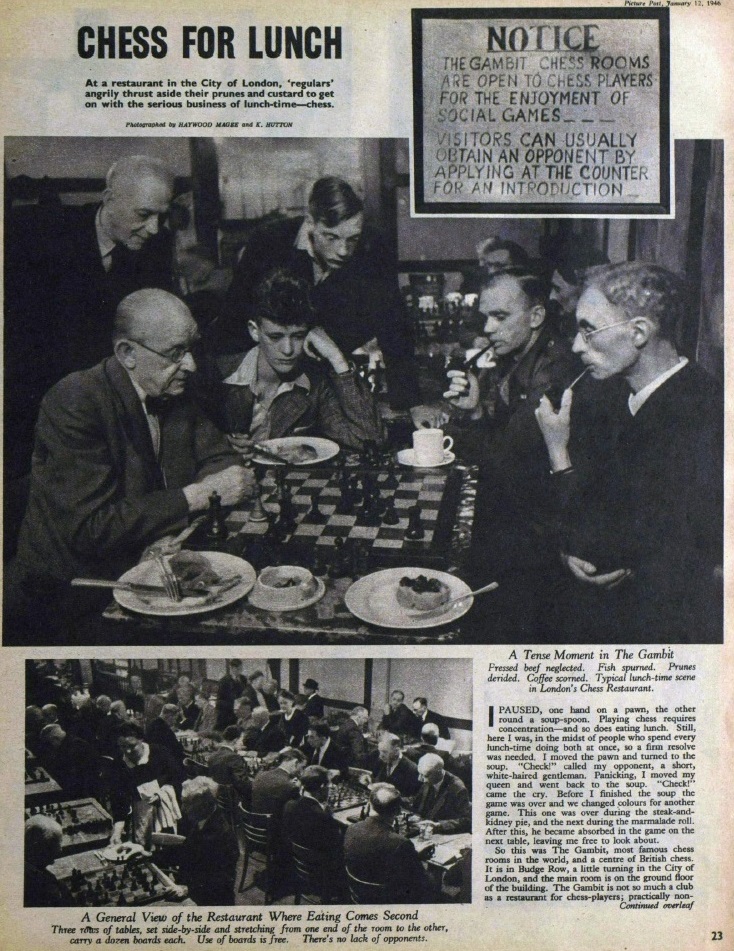
(8975)
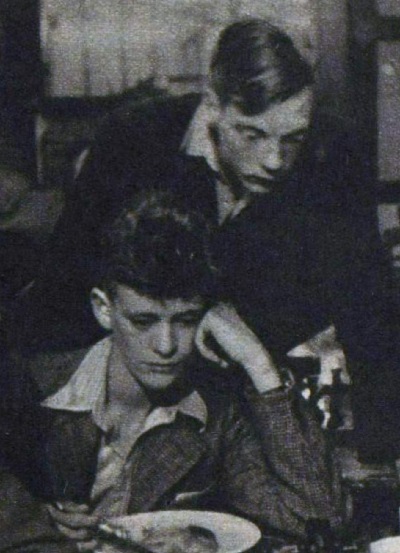
Picture Post, 12 January 1946, page 23
Leonard Barden writes:
‘The young man standing is John Fuller, the 1949-50 Hastings Premier and British championship player who at the time of the photograph had just shared first place with me in the London under-18s championship.
The spectator seated below him is, I believe, a young Jim Slater, the saviour of Reykjavik 1972, who was at that time a keen player and a good friend of Fuller’s at their school in Harrow.’
(9016)
We have prepared a list of books written by Leonard Barden:
The list does not include translations of these books, or books by other authors which he translated or revised or to which he made a contribution. Examples of those four categories are, respectively:
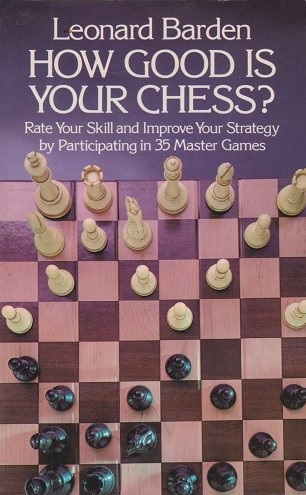
(9017)
The Introduction to Chess. Master the moves was written by Brian Walden (1932-2019):
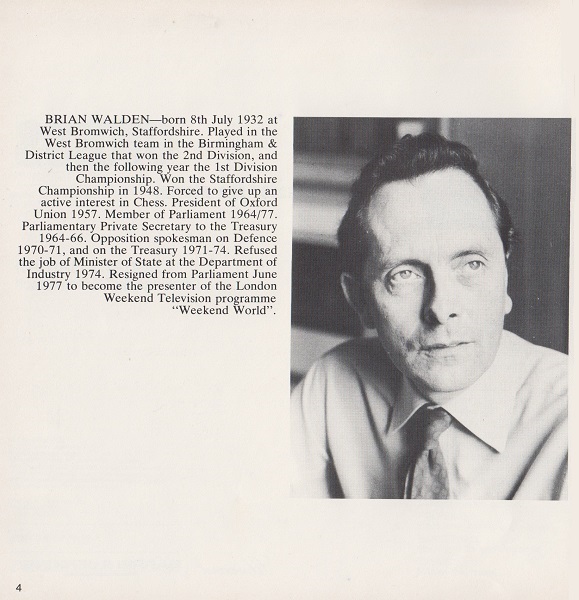
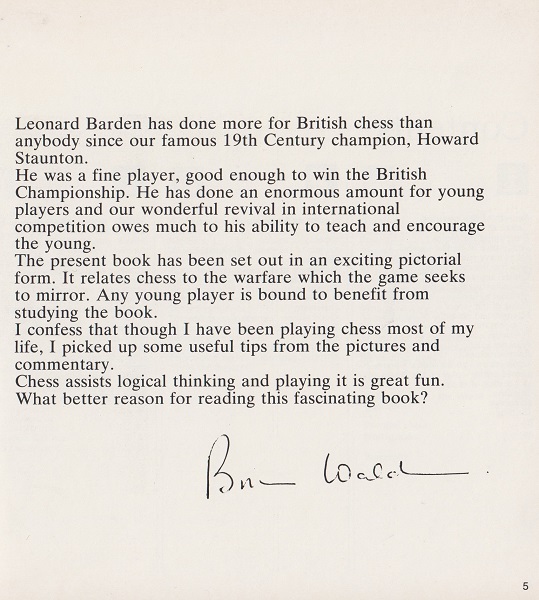
Regarding The Batsford Chess Puzzle Book see C.N. 2907 (reproduced on pages 230-231 of Chess Facts and Fables).
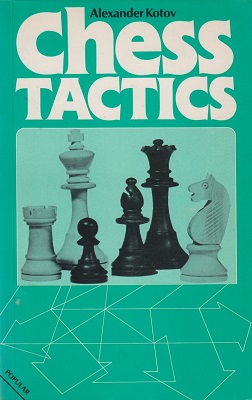
Future C.N. items will examine some positions in Chess Tactics by Alexander Kotov (London, 1983). First, though, attention is drawn to the concluding ‘Translator’s Note’ (pages 142-143), a tribute by John Littlewood to Kotov, who had died in 1981. We wonder what lay behind the crusty second paragraph:
‘It has always struck me as sad that the younger generation of British players did not see Kotov visit this country until he was over 30 years past his prime, brought in as an ageing grandmaster to bestow dubious prestige on some ostensibly budding World Champion who managed to beat him during a simultaneous exhibition ...’
From Leonard Barden:
‘At the time John Littlewood wrote his comment about Kotov I wondered what he had in mind. I organized two clock simultaneous exhibitions for Kotov in London against selected juniors. One, on about ten boards, was during the Lord John Cup in September 1977. All the competing grandmasters (the others were Hort, Quinteros and Torre) gave clock displays on the free day. Hort crushed the strongest group, which included the future grandmasters Daniel King and William Watson. Kotov had the weakest group and scored well, though losing one or two. The other occasion was in early November 1978, when Kotov gave a 12-board exhibition against selected under-13 juniors. His score (6 –3 =3) was good, given the tough opposition. Neil Carr won a widely published game.
Kotov had a heart condition and told me that he was glad to have the simultaneous assignments because he could use the money to buy medication, for himself and his wife, which was not available in the Soviet Union. He did not appear to have any physical problems during either event.
I remember thinking in the 1980s that John Littlewood’s comment would have had more weight if made in connection with the three-game match at Borehamwood in November 1979 which Kotov lost to Ian Wells (one win and two defeats). Wells was then aged 15. Kotov made several errors in those games and was suffering physically after around three hours’ play.’
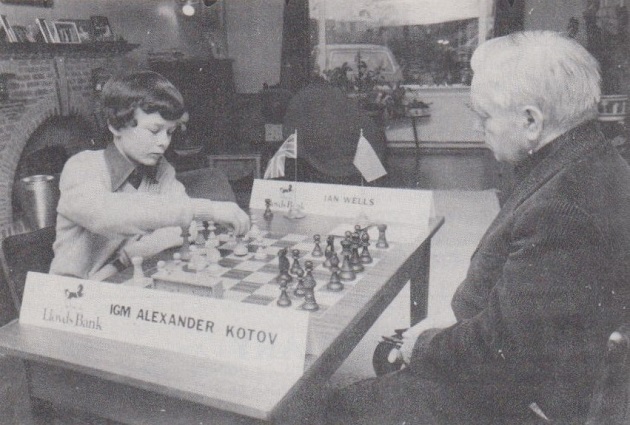
BCM, March 1982, page 102
The report on pages 1-2 of the November 1979 CHESS stated that before the match with Kotov, Wells had never played against a grandmaster. Their post-match comments were quoted:
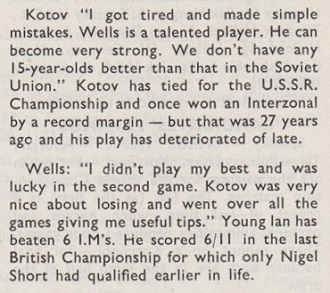
With regard to that match, Mr Barden informs us:
‘It was held at the home of Malcolm Fox, who was then the organizer of the annual Borehamwood congress. He was a nephew of the many times Canadian champion Maurice Fox. Malcolm Fox made the arrangements and provided hospitality for both players. His son Neil was a talented junior and played some blitz games with Kotov during the match. Kotov was persuaded to play the match when I told him that Wells was from the same part of the country, and of similar promise for his age, as Gordon Crown was in 1947.’
Certain databases suggest that in 1979 there was also a match, in Brighton, between Lodewijk Prins and Ian Wells, but the Dutchman’s opponent was Peter Wells. For example, the following appeared in a report by J. Speelman on pages 95-96 of the March 1980 BCM:
‘... a match between IM Ludovic [sic] Prins (NL) and Peter Wells, the British U-16 champion.’
From page 144 of The World Chess Championship 1963 by R.G. Wade (London, 1963):
‘Botvinnik has the mannerism, when he reaches at last a satisfactory position, of straightening his tie.’
A number of Botvinnik’s opponents have remarked upon this mannerism, including Leonard Barden in his Evening Standard column of 7 July 2014, which gave a position from their game in Hastings on 31 December 1961. (He annotated the complete game on pages 85-87 of the March 1962 BCM.)
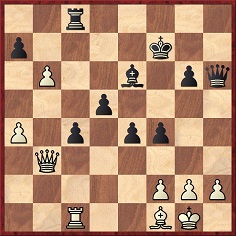
By playing 33 Qb4 White missed an opportunity.
From the Evening Standard column:
‘The world champion reacted to my queen move with a thin smile, then adjusted his tie. This was a demoralising gesture for me, for everybody knew that Botvinnik’s tie routine was invariably a signal that the great man was satisfied with his position or had just escaped from danger.’
Gordon Taylor (Kanata, Ontario, Canada) recently acquired How to become Chess Champion (Pankaj Publications, New Delhi), a 263-page book with no publication date or author mentioned. The imprint page:
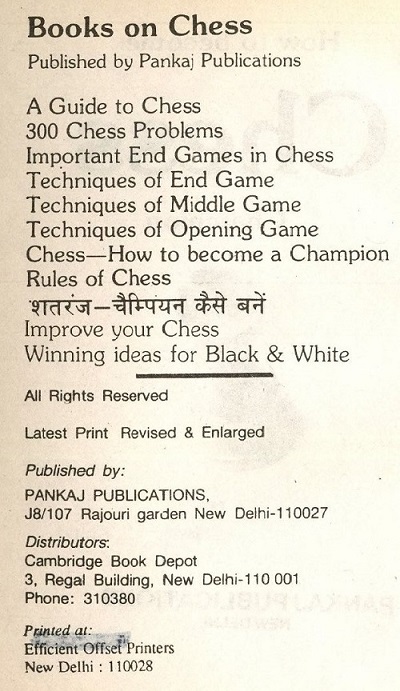
Our correspondent also noted that an on-line vendor was offering a book with the same title and from the same publisher but with authorship ascribed to Philip Robar, who is mentioned in An Indian Copying Mystery.
Mr Taylor’s particular attention was drawn to a passage on page 105:
‘Sometimes the player making the sealed move (see page 111) can do something unexpected; then that move should be made quickly and confidently and the ensuing moves followed up in a barrage.
I was on the receiving end of this technique in the 1957 British Championship against R.G. Wade, when I adjourned with a good position and expecting to win and take a clear tournament lead. But the pressures of being blitzed with surprise moves after adjournment induced a losing blunder.’
Mr Taylor concluded that the game in question was Wade v Barden, Plymouth, 1957, and he has asked us to comment on a sample of seven full pages which he has kindly forwarded. They include these two:
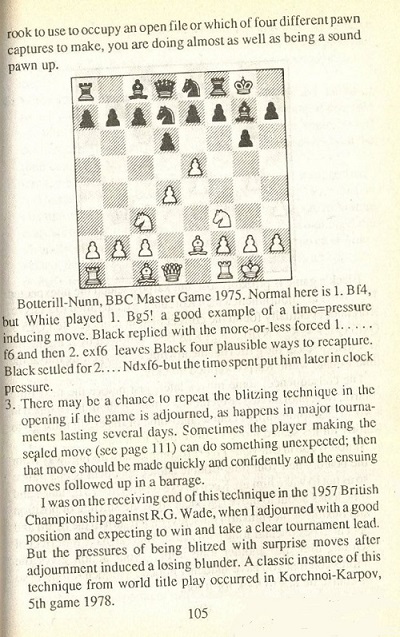
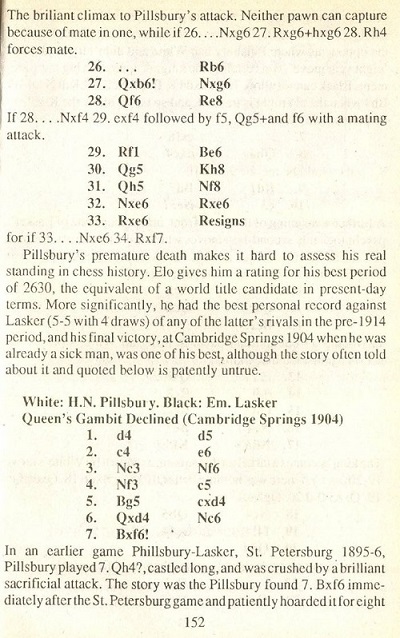
We can say that all seven pages are copied, in full, from Play Better Chess by Leonard Barden (London, 1980). The two shown above are from, respectively, pages 143 and 58.
This photograph was on page 6 of the Universities Chess Annual, November 1950 and on page 37 of CHESS, November 1950:
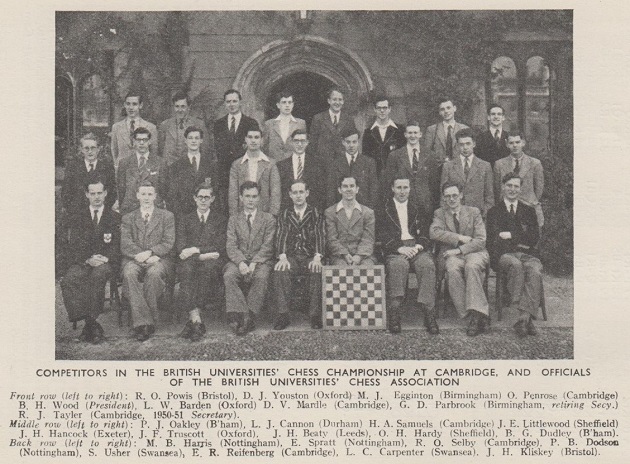
(9169)
A remark by Imre König about Leonard Barden in a report on the 1949 British championship in Felixstowe:
‘Barden’s knowledge of theory is extraordinary, he is a walking compendium of MCO and Bilguer.’
Source: BCM, September 1949, page 312.
After quoting this on page 282 of the 1 December 1949 Chess World, C.J.S. Purdy wrote:
‘Understatement! He is years ahead of the latest editions of both. Barden is 20 – a modern history student at Oxford.’
Chess Mastery by Question and Answer by Fred Reinfeld (London, 1940). In his Evening Standard column of 30 December 2015 Leonard Barden reported that it was ‘the first book which really improved my own chess’ and that it ‘is still a worthwhile read’.
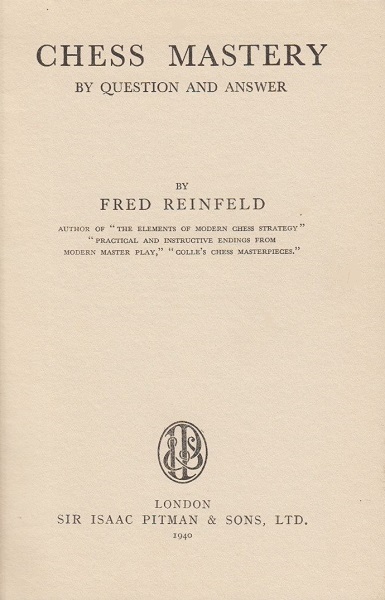
(9746)
A comment by C.J.S. Purdy about A Guide to Chess Openings by Leonard Barden (London, 1957), on page 104 of the April 1957 Chess World:
‘... it’s the best book on openings ever.’
(9928)
Recorded material from the 1960 Olympiad in Leipzig was included in the BBC radio programme about chess broadcast on Network Three on 23 April 1961, beginning at 16.00:
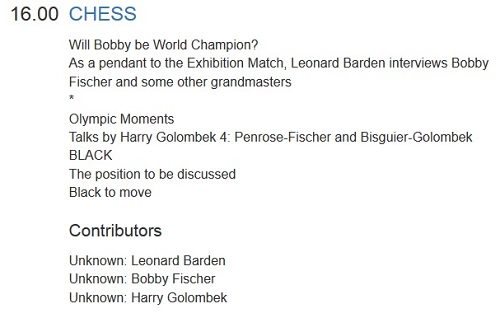
The BBC Written Archives Centre has informed us that the PasB (Programme-as-Broadcast) documentation merely states:
‘Interviews: (recorded at the Leipzig Chess Congress)
Between Leonard Barden
and various Grandmasters (NF).’
‘NF’ stands for No Fee, which means that the BBC did not enter into contracts with the interviewees and, therefore, did not list them individually on the PasB.
From Leonard Barden:
‘My clear recollection of the recordings which I made during the 1960 Olympiad is that they were not really interviews in the normal sense, but informal memory tests, seeking recall of one or two key moments from the games of others and one or two from the subject’s own play, with a few supplementary questions arising from the flow of the conversation.
Before the British Chess Federation team left for Leipzig, the BBC issued me with a heavy tape-recorder, which I carried over my shoulder and which was an extra to my suitcases. They housed thick loose-leaf volumes of handwritten openings data plus what turned out to be the most valuable item of all: a copy of the latest Deutsche Schachzeitung, which the postman delivered just as I was leaving the house. It contained the Ojanen v Keres game (Modern Benoni) that Jonathan Penrose consulted to effect on the morning of the final round before his game with Tal.
After I arranged interview times with the subjects in Leipzig, I found that the tape recorder batteries no longer functioned. So I went to the Leipzig branch of GUM, the main department store chain then in Eastern Europe, and bought replacements. These did not work either. I then arrived at the local radio station. As I hoped, it was impressed to have a visitor from the BBC, and it took pleasure in providing me with working batteries. Somewhat daring in the ambiance of the time, I ventured a political joke: capitalist batteries did not work, but communist batteries were no better. This was well received, and we parted amicably.
The subjects of the quasi-interviews included Tal, who had the best memory of all, as one would expect from other well-known reports around that time of his phenomenal powers of recollection. Choosing a game from his youth, I asked about his loss to Lev Aronin at Riga, 1954. In retrospect, this was probably not a good test choice since the game was noteworthy as an early example of the Tal sacrificial style, taking on the Caro-Kann and sacrificing a bishop at e6 and a knight at g5 to keep the black king in the centre, before missing a probable win by 17 Rxe5+. Tal responded by repeating the pre-game banter between the players, the course of the game itself, and a further conversation with Aronin at the post-mortem. He also had excellent recall when I asked him about games by a couple of other grandmasters.
Korchnoi received me at noon when he was still in bed, smoking, and told me amid coughs that he used one-mile runs for physical training, a claim which provoked my scepticism but, of course, was perfectly true. His memory test performance was quite good.
Gligorić surprised me negatively since I had assumed that as a highly professional and dedicated chess worker he would have a good memory. In fact, he had poor recall even of his own games.
Finally, Fischer had a good memory of a couple of his early games from the mid-1950s, but could recall little when I asked for his recollections of games by his rival Reshevsky.’
The famous Penrose v Tal game referred to by Mr Barden was annotated by Penrose on pages 360-362 of the December 1960 BCM. After 1 d4 Nf6 2 c4 e6 3 Nc3 c5 4 d5 exd5 5 cxd5 g6 6 e4 d6 7 Bd3 Bg7 8 Nge2 he wrote:
‘I was aware that these moves had been played earlier in the year in a game Ojanen-Keres, and although I could not recollect the further course of the game very well, I thought that a variation good enough to lead to the defeat of Keres must be a very good one.’
The Ojanen v Keres game, played in a match between Finland and Estonia (Helsinki, 15 May 1960), had been published on page 224 of the July 1960 Deutsche Schachzeitung with notes by Eero Böök. Two books which discuss it, as well as Penrose’s victory over Tal, are Ojasen oival luksia by K. Ojanen and V. Salonen (Toijala, 1975) and Kaarle Ojanen – elämä ja pelit by H. Hurme, I. Kanko, J. Norri and P. Saharinen (Helsinki, 2009). See, respectively, pages 67-71 and pages 174-177.
See too C.N. 9831.
From page 106 of CHESS, 10 December 1960:
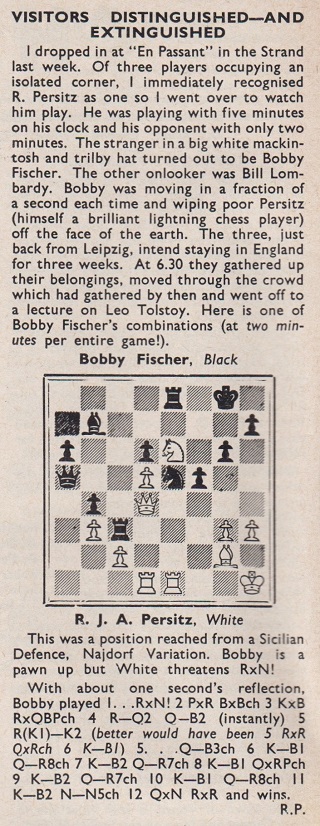
From Leonard Barden:
‘The writer in CHESS, ‘R.P.’, was probably Roland Payne, a strong blitz player and a regular at the “En Passant” in the Strand. He had an excellent kibitzer memory and was well capable of reconstructing the Persitz v Fischer fragment.
The reference to Fischer going to a Tolstoy lecture may sound odd, but 20 November 1960 was the 50th anniversary of the death of the Russian writer (and chessplayer), and there were lectures in both England and the United States to mark the occasion. The academic Isaiah Berlin recorded one such lecture for the BBC on 23 November.’
Leonard Barden writes:
‘The second page of the May-June 1970 issue of Latvian Gambit shown in C.N. 10122 states:
“Since that time [summer 1967] chess masters have not challenged Jutta.”
I should draw attention to Jutta Hempel’s disaster against Elaine Pritchard (who was a woman international master) which I personally witnessed.
Two games were played by radio by arrangement with the BBC World Service and a German radio station in autumn 1967. Elaine Pritchard had been a prodigy in the late 1930s, when she won the world girls’ and British women’s titles and performed well against Alekhine and Spielmann in simultaneous exhibitions. The objective of the radio programme was to find out how the two prodigies compared.
In the first game, Jutta Hempel had White and played to the standard of a weak club player and was crushed quickly by a king’s-side attack: 1 e4 e5 2 Nf3 Nc6 3 Bc4 Bc5 4 O-O d6 5 d3 Nf6 6 Bg5 h6 7 Bxf6 gxf6 8 h3 Be6 9 Bxe6 fxe6 10 Nc3 Qd7 11 Qd2 Qg7 12 Ne2 Rg8 13 Ng3 Qxg3 14 Ne1 Qxh3 15 c3 O-O-O 16 b4 Rxg2+ 17 Nxg2 Rg8 18 White resigns.
In the second game, she played 2...f6 and lost like a beginner. When the move came through from the German announcer, Elaine shook her head and shrugged. There was even more astonishment in the BBC studio at Black’s third move. The full game: 1 e4 e5 2 Nf3 f6 3 Nxe5 fxe5 4 Qh5+ Ke7 5 Qxe5+ Kf7 6 Bc4+ Resigns.
Afterwards, Jutta Hempel’s father could only say that she was nervous on the big occasion. But, of course, she had already successfully coped with even more demanding situations. Two leading German players of the time, Lothar Schmid and Rudolf Teschner, expressed scepticism to me about Jutta Hempel’s claimed exploits. The respected Deutsche Schachzeitung, edited by Teschner, never publicized her results, unlike the rival Schach-Echo, which was her major chess publicity outlet.
The two games against Elaine Pritchard can be found on-line easily enough, although they are wrongly attributed to her husband, David Pritchard.’
In C.N. 1304 Mr Barden drew our attention to his article on Jutta Hempel in The Field, 14 September 1967.
From page 189 of CHESS, March 1968:
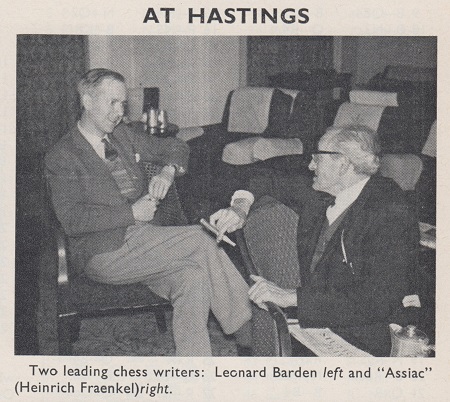
From Leonard Barden:
‘Heinrich (Heinz) Fraenkel had a noticeable German accent, but otherwise his spoken English was clear and grammatical. I believe, though, that his written English on non-chess subjects had a much wider vocabulary. He was quite loquacious and opinionated when he got going and was usually reluctant to end a conversation. During chess discussions he sometimes alluded to his major professional work on the Nazi leaders, but never obtrusively or in any detail. He was proud of his New Statesman column and liked to ask probing questions designed to provide new material, which did not bother my generation but sometimes irked the younger masters (especially Tony Miles) who had designs on his job.
Wolfgang Heidenfeld, who was my co-author in a book of miniatures and whom I played at least twice in tournaments, was originally German but had lived for many years in South Africa, and he had elements from both countries in his speech. He occasionally used words which echoed other German English-speakers, while his accent and tone were slightly lilting and high-pitched, like other South African players I knew, such as Kenneth Kirby.
Ernst Klein had only a slight German or Austrian accent, but he spoke in a rather clipped and brusque manner. He did not like being reminded of his pre-War roots, and asked to be called Ernest in the London, 1973 bulletin (the event discussed in C.N. 7725). I played both Jacques Mieses and Paul List, but we did not have any significant conversations. Imre König had a notably quiet speaking tone, though those who knew him later in the United States will have clearer recollections.
Dr Stefan Fazekas had a thicker accent than the others, and his English, though perfectly adequate, as it had to be since he was a GP, was both more voluble and less colloquial. It took a lot to silence him, though William Winter managed it in the British championship at Buxton in 1950 when the doctor continued playing in an ending which was clearly destined for bishop and wrong-colour rook’s pawn. It was in the evening adjournment session, around 21.45, and Winter got up from the board and said, “You can continue trying to win this, Doctor Fazekas, until the cows come home. I’m off to the pub!’ Twenty minutes later, at closing time when Winter returned and banged down his king at h8 for emphasis, Fazekas reddened and sheepishly agreed to the draw.
I knew Čenĕk Kottnauer best of all since I was a fellow competitor at Lucerne, 1952-53 when he announced his defection, as I mentioned in C.N. 8160. After he settled in London I often visited his home near Marble Arch for the excellent meals prepared by his wife Danielle and for a couple of hours of five-minute blitz. Like Fazekas, Čenĕk had quite a strong Czech accent. Although we often talked about chess matters, he preferred a succinct approach, so that I never got much out of him about, for example, the wartime tournaments in Prague and his encounters with Alekhine, Junge, and Bohatirchuk. The subject which used to set him off was Ludĕk Pachman, whom he regarded as his enemy and, along with Opočenský, behind the manoeuvres which forced him into exile from his work in the sports ministry.
My main language memory, though, is the excellent spoken English of the Dutch masters at the annual England v Holland match in the late 1950s and early 1960s. Euwe, Cortlever, van Scheltinga and, especially, Prins had good vocabularies, while the team manager and later FIDE Secretary, Hendrik J.J. Slavekoorde, was a dedicated linguist who used to quiz me every year about obscure points of syntax.’
On page 66 of Profile of a Prodigy by Frank Brady (New York, 1973) the possibility of a Botvinnik v Fischer match was referred to in a section about the Olympiad in Varna in 1962:

From page 21 of CHESS, 24 November 1962:
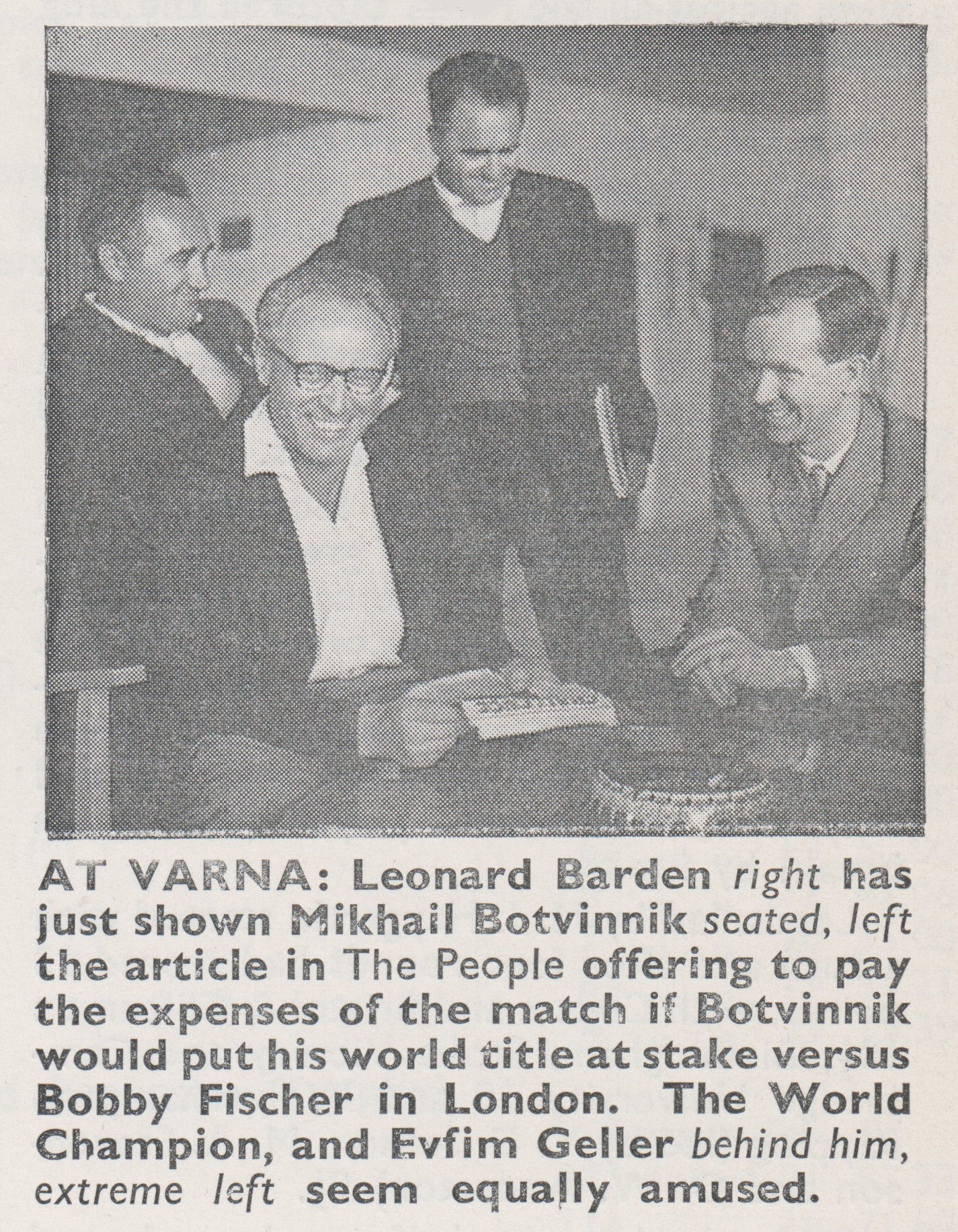
Can any reader supply the People article?
(10956)
On 3 January 2023 we gave the full text of the (Sunday) People article in Bobby Fischer Miscellanea.
From our file of Evening Standard cuttings we present a montage of some articles by Leonard Barden:
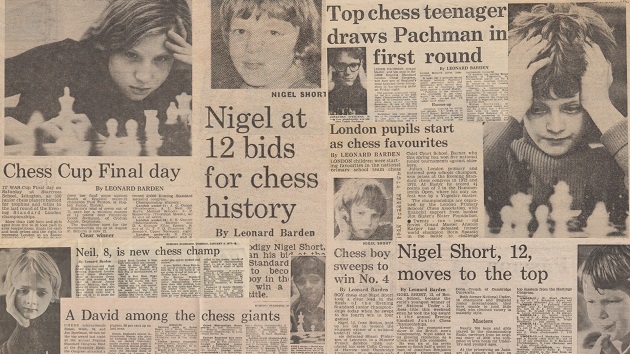
The players are Neil Carr (4 January 1977), Julian Hodgson (11 May 1974), Simone Leberman (7 January 1974), David Norwood (1 August 1977), Nigel Short (28 December 1977, 30 December 1977 and 3 January 1978) and Jonathan Speelman (12 December 1972).
C.N. 10989 showed this report:
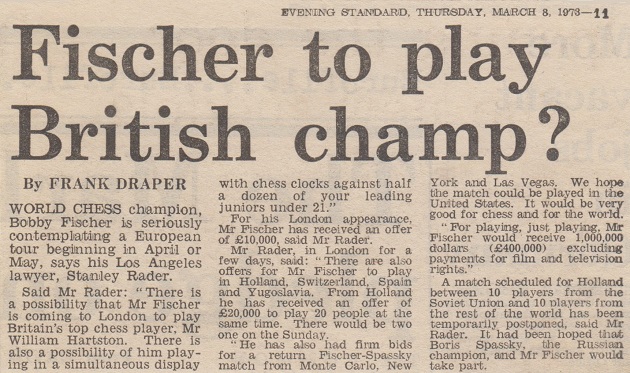
An addition from page 157 of CHESS, March 1973:
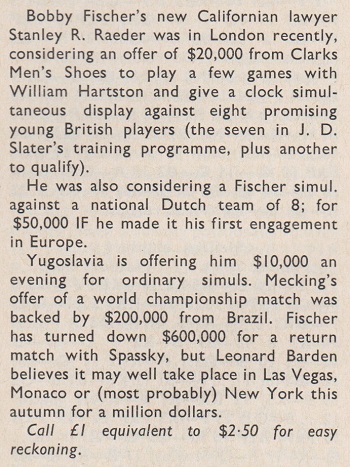
Leonard Barden informs us:
‘I was contacted in early 1973 by Clarks Shoes, who wanted to sponsor a chess event involving Bobby Fischer. Since the maximum budget (probably £10,000, but I do not recall exactly now) was unrealistically low, I suggested Spassky instead, but the company was adamant that only Fischer would be acceptable.
After consultation with Stewart Reuben, I contacted Stanley Rader with a proposal for a two-game match between Fischer and the then England No. 1, William Hartston, with games in London and York, plus a clock simultaneous display against eight English juniors.
I had zero expectation that this offer would be accepted. My hope was that the match format would be quickly rejected (“Two games? You gotta be joking!”), but that Fischer would be interested in the simultaneous exhibition with clocks.
My main basis for optimism was that in July 1972, after Fischer accepted Jim Slater’s offer to double the prize fund at Reykjavik, his then lawyer Paul Marshall told me that Fischer was very grateful and that as a thank-you would play in England in his first event after he won the title. Of course, I told that to Stanley Rader. My hope also was that a clock simultaneous exhibition against eight opponents, two of whom would be girls, would sound sufficiently lightweight for Fischer to accept as an easy way of keeping his promise to Slater.
The small print, and the reason I took the trouble to be involved in such a time-consuming episode, was that the England junior team would have been Tony Miles, Michael Stean, John Nunn, Jonathan Mestel and Jonathan Speelman, all future strong grandmasters, plus one other undecided name (probably David Goodman). The girls would have been Sheila Jackson and Susan Caldwell, the obvious choices at that time.
I was also ready, if it clinched the event, to reduce the numbers to just the five players who I was sure had world-class potential.
There was no reply from the United States for several weeks, and Clarks Shoes became fidgety, so I telephoned Stanley Rader’s office and repeated the proposal, emphasizing that there was room for negotiation and that the event was possible as just a five-board simultaneous exhibition. Rader told me that Fischer was physically present in his office, and put me on hold while they spoke. Fischer knew me well from our BBC consultation game and his 1960 visit to my home, but would not speak directly to me. Rader told me that Fischer was undecided and that they would let me know later. After a couple of weeks a final negative reply came. At some stage, possibly after the breakdown of negotiations, a story about the abortive match appeared in the Daily Telegraph mentioning Clarks Shoes as the would-be sponsor. Clarks paid me just £100 for my work in trying to arrange the event, so received excellent value for that outlay in the subsequent publicity.’
From the Sunday Times, 7 January 1962, page 38 (magazine section):
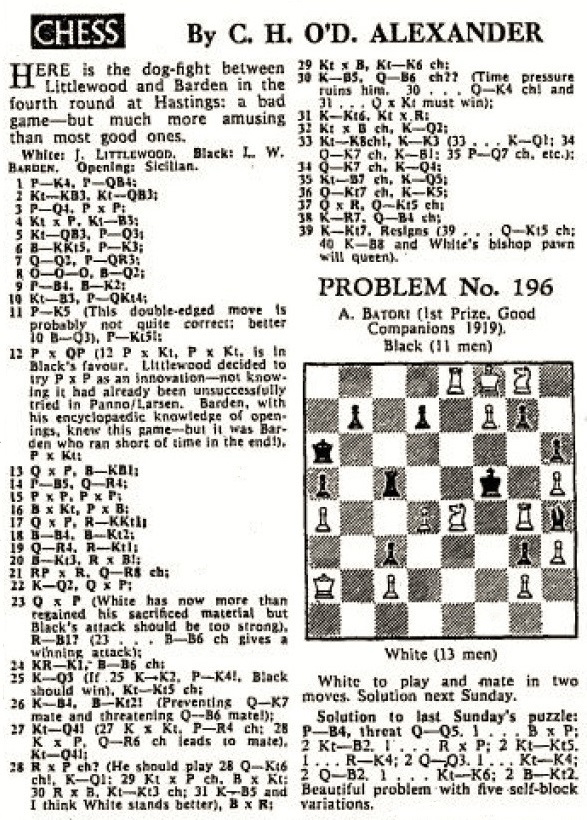
1 e4 c5 2 Nf3 Nc6 3 d4 cxd4 4 Nxd4 Nf6 5 Nc3 d6 6 Bg5 e6 7 Qd2 a6 8 O-O-O Bd7 9 f4 Be7 10 Nf3 b5 11 e5 b4 12 exd6 bxc3 13 Qxc3 Bf8 14 f5 Qa5 15 fxe6 fxe6 16 Bxf6 gxf6 17 Qxf6 Rg8 18 Bc4 Bg7 19 Qh4 Rb8 20 Bb3 Rxb3 21 axb3 Qa1+ 22 Kd2 Qxb2 23 Qxh7 Rf8 24 Rhe1 Bc3+ 25 Kd3 Nb4+ 26 Kc4 Bg7 27 Nd4 Nd5
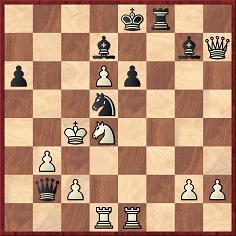
28 Rxe6+ Bxe6 29 Nxe6 Ne3+ 30 Kc5 Qc3+ 31 Kb6 Nxd1 32 Nxg7+ Kd7 33 Ne8+ Ke6 34 Qe7+ Kd5 35 Nc7+ Kd4 36 Qg7+ Ke4 37 Qxf8 Qb4+ 38 Ka7 Qc5+ 39 Kb7 Resigns.
The game was played in round four of the Hastings tournament, on 30 December 1961. White’s final move was not 39 Kb8 as given in some databases. When the ‘dog-fight’, as Alexander termed it, was annotated on pages 134-135 of CHESS, 19 January 1962, his remark, ‘a bad game – but much more amusing than most good ones’, was quoted together with the following:
‘A real English-style game’ (M. Botvinnik).
‘Littlewood plays the best bad chess I have ever seen.’ (L. Lindheimer).
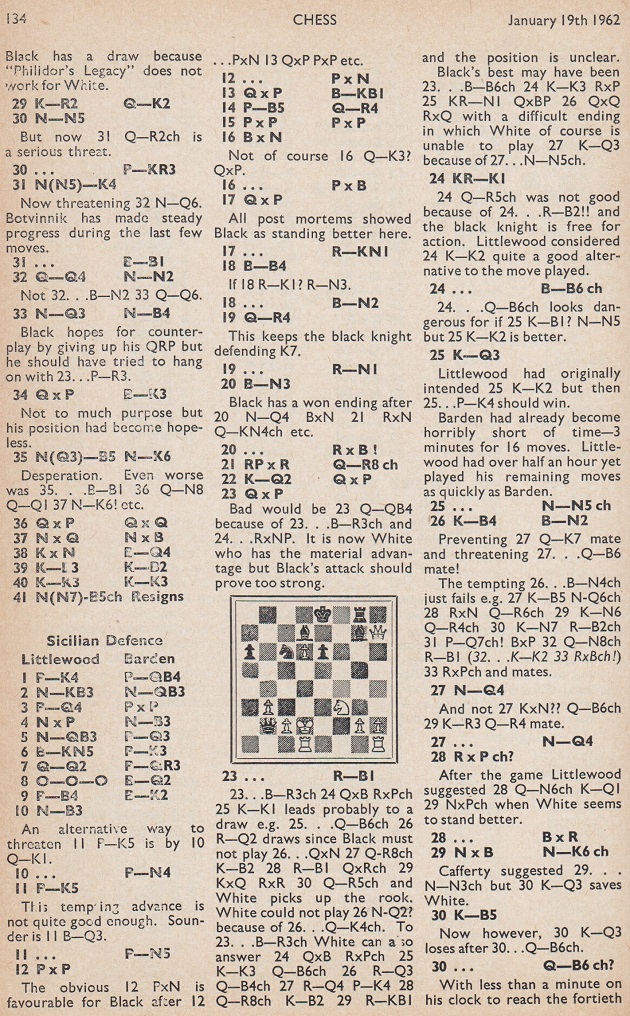
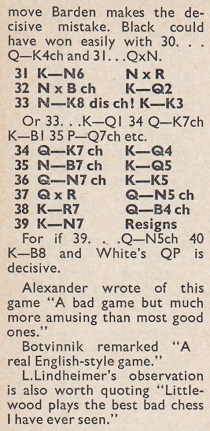
Some complementary notes from Richard Forster (Zurich):
‘14 f5. The whole line appears to be dubious for White. 14 Bc4 was tried in some later grandmaster games, with modest results.
20...Rxb3. 20...Qf5 (Burger-Mednis, New York, 1969) is a good alternative.
24 Rhe1. A new move. 24 Qh5+ Kd8 25 Qh4+ Ke8 26 Qh5+ Rf7 had led to a quick defeat for White in Larsen-Panno, Mar del Plata, 1958. 24 Ke2 had been tried in another earlier game, Holaszek-Minaya Molano, The Hague, 1961; after 24...Nb4 Black still enjoys the better game. 24 Qe4 may be relatively best.
24...Bc3+. An even stronger line is 24...Qc3+! 25 Ke2 Ne5!, as 26 Qxg7 loses to 26...Bb5+ 27 Kf2 Nd3+ 28 Rxd3 Qxg7.
25 Kd3?! Objectively, 25 Ke2 was the lesser evil, although after 25...e5 (26 Rd5) or simply 25...Bxe1 Black keeps the advantage.
25...Nb4+. The mundane 25...Bxe1 26 Rxe1 Qa3 should win quite easily as White loses the d6 pawn.
26...Bg7? The third inaccuracy in a row and quite a significant one. Firstly, 26...Rf4+ is stronger. Retreating the knight to c6 also keeps a clear advantage. After the game move, White could have forced a draw by perpetual check with 27 Qh5+! Kd8 28 Qa5+ Ke8 29 Qh5+ since 29... Rf7 30 Ne5 is plainly bad.
27...Nd5? Here the unusual 27...Na2! with the same threat was much stronger. The point is that unlike in the game the knight is not attacked by the king. After 28 Re3 Bb5+ 29 Nxb5 axb5+ 30 Kd3 (30 Kxb5 Kd7!) 30...Qd4+ 31 Ke2 Nc3+ 32 Rxc3 Qxc3 33 d7+ Kd8 Black ought to win.
28 Rxe6+? 28 Qg6+ Kd8 29 Nxe6+ is indeed better, but it is still White who must be glad that after 29...Bxe6 30 Rxe6 Nb6+ 31 Kd3 Qd4+ 32 Ke2 Qf2+ 33 Kd3 Black has no more than perpetual check.
30 Kc5. White is still lost. After 30 Kb4 Black would need to find 30...Qc3+ 31 Ka4 Rf4+!! 32 Nxf4 Qc6+ 33 Ka3 Qc5+ 34 b4 Nxc2+ with a mating attack (35 Ka2 Qc4+).
30...Qc3+? The turning point. 30...Qe5+ 31 Kb6 Qxe6 does indeed win easily.
31...Nxd1. There is no salvation: 31...Qb4+ 32 Kxa6! Qa3+ 33 Kb5 Rf5+ 34 Qxf5 Nxf5 35 d7+ and wins. 31...Rf7 32 Qg8+ Bf8 33 d7+. Or 31...Nf5 32 Qg6+! (not 32 Nxf8? Bd4+) 32...Kd7 33 Nxf8+, etc.’
Leonard Barden’s obituary of John Littlewood (Guardian, 26 September 2009) described him as ‘the finest UK attacking player of his generation’.
Littlewood was also praised by William Lombardy on pages 36-37 of Chess Life, February 1962. For example:
‘It is easy to see how Littlewood could beat any player at any given time, since he does not appear to be in the least timid about sacrificing material early in the game.’
On page 72 of the March 1962 Chess Review Bruce Hayden reported that on the evening of 28 December 1961 Littlewood was referred to by visiting masters as ‘der kleine Tal’ after his spectacular, though unsuccessful, attack against Botvinnik in the Hastings tournament. The world champion annotated the game on pages 129-130 of CHESS, 19 January 1962.
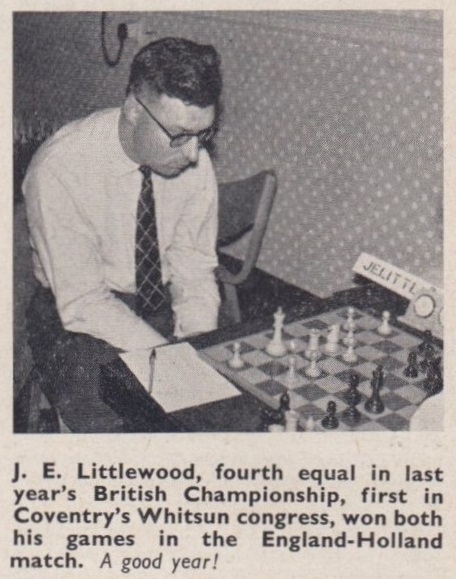
CHESS, 25 November 1960, page 93.
Leonard Barden writes:
‘My game against John Littlewood at Hastings, 1961-62 was traumatic for me. For once I got my preparation spot on, had that morning revisited Larsen v Panno, Mar del Plata, 1958, and was stunned when Littlewood, finding it all slowly at the board, reached the identical position after 23 moves before varying with 24 Rhe1. I had taken around five minutes to his one hour, and assumed that I was winning.
Expecting to find a mate with his king at c4, I in turn thought for too long and lost my objectivity. I feel that I was fated in that tournament since I also missed a forced draw against Botvinnik.’
Leonard Barden’s obituary of Mark Taimanov, in the Guardian, 29 November 2016, is outstanding.
The earliest over-the-board game by Leonard Barden that we recall seeing was played in the British Boys’ Championship in Hastings in April 1946. From page 141 of the May 1946 BCM:
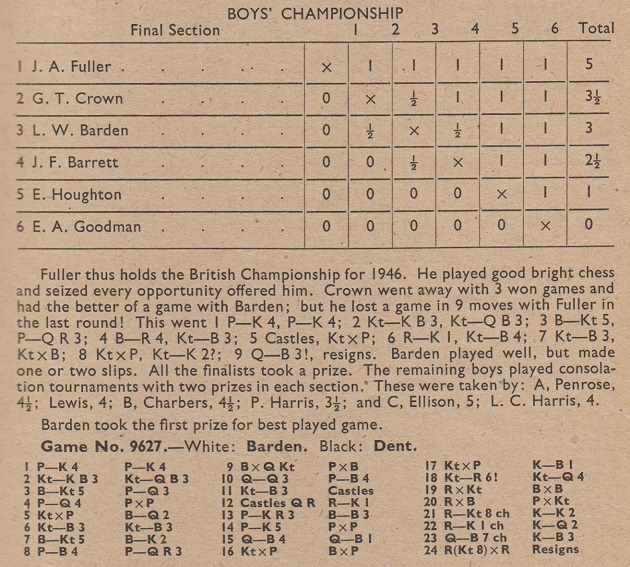
1 e4 e5 2 Nf3 Nc6 3 Bb5 d6 4 d4 exd4 5 Nxd4 Bd7 6 Nc3 Nf6 7 Bg5 Be7 8 f4 a6 9 Bxc6 bxc6 10 Qd3 c5 11 Nf3 O-O 12 O-O-O Re8 13 h3 Bc6 14 e5 dxe5 15 Qc4 Qc8 16 Nxe5 Bxg2 17 Nxf7 Kf8
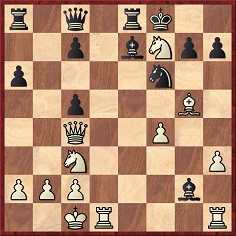
18 Nh6 Nd5 19 Rxd5 Bxg5 20 Rxg5 gxh6 21 Rg8+ Ke7 22 Re1+ Kd7 23 Qf7+ Kc6 24 Rgxe8 Resigns.
Page 168 of CHESS, May 1946 mentioned that the prize was given by Sir George Thomas. He was in the group photograph accompanying a report by A.J. Mackenzie on page 1 of the Hastings and St Leonards Observer, 20 April 1946. Can a better copy be found?
We sent a preview of the present item to Leonard Barden, who has commented:
‘I have no memory of that victory, though I recognize the opponent’s name. On the other hand, I have a strong negative memory of playing Fuller, where I chose the Wing Gambit and left my a5 rook en prise to a black knight quite early on, and a strong positive memory against Crown, where I stood slightly worse throughout as Black in a Queen’s Indian Defence but defended well to draw a difficult rook ending.
Sir George Thomas was an active spectator at major junior events in London and Hastings at that time and was very alert to pointing out tactical opportunities that the players had missed – including one of my own against Barrett at Hastings which could have enabled me to share second place.’
(11642)
From page 19 of CHESS, October 1952:
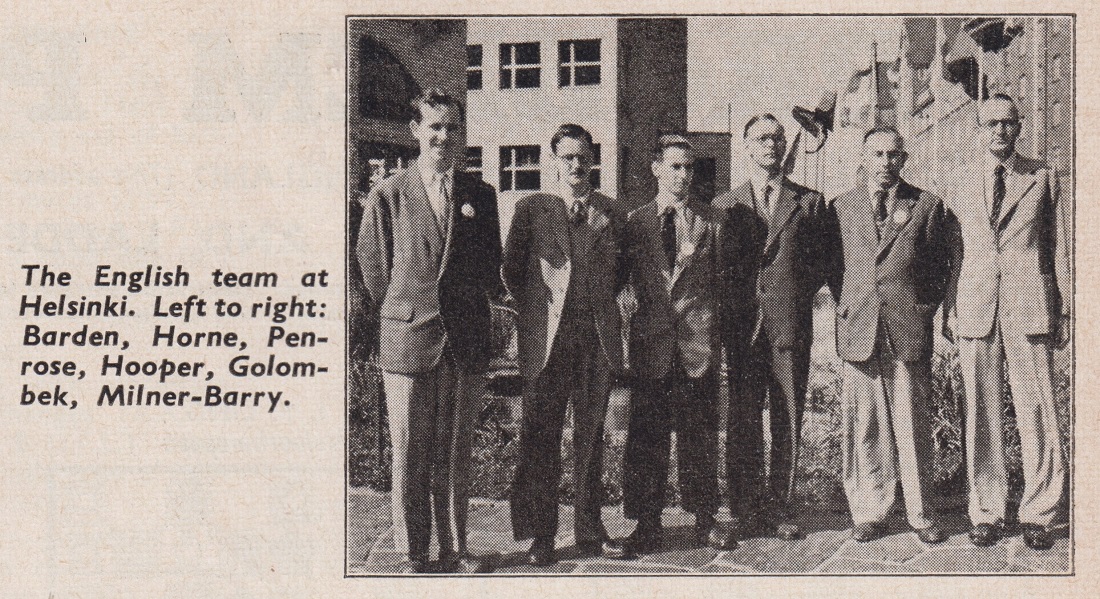
Addition on 12 March 2023:
The two photographs below (Pergamon Chess Club, Oxford, March 1973) have been provided by Olimpiu G. Urcan, courtesy of the Oxford Mail archive:
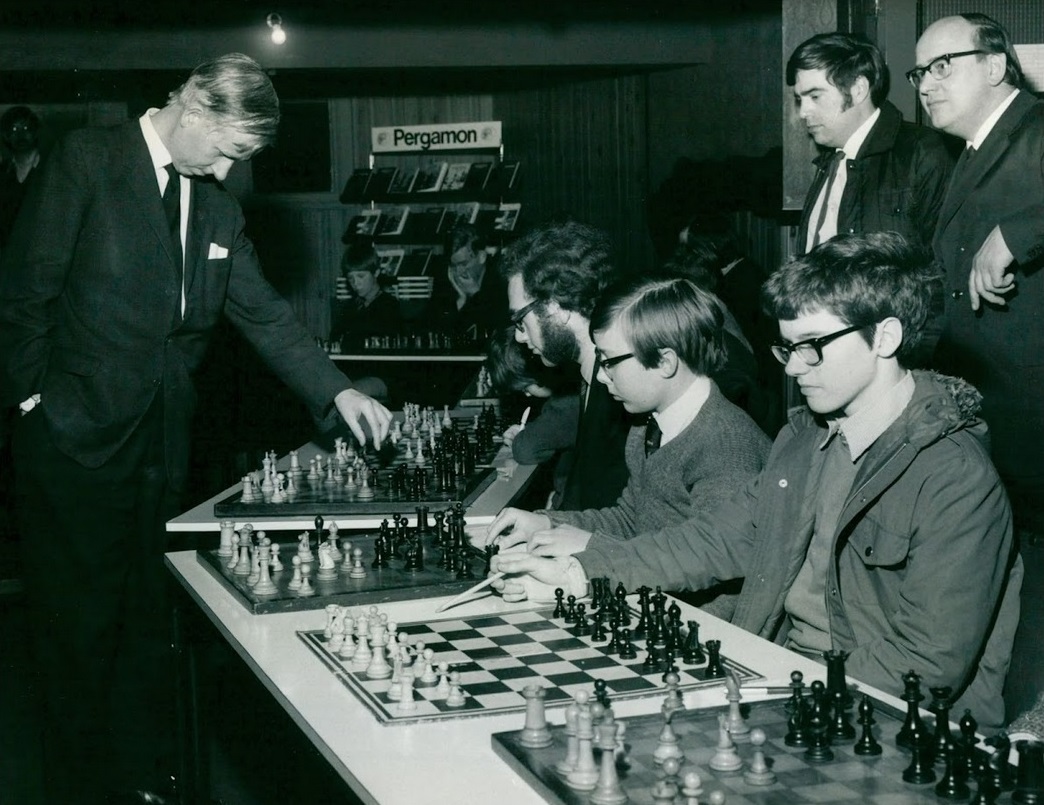
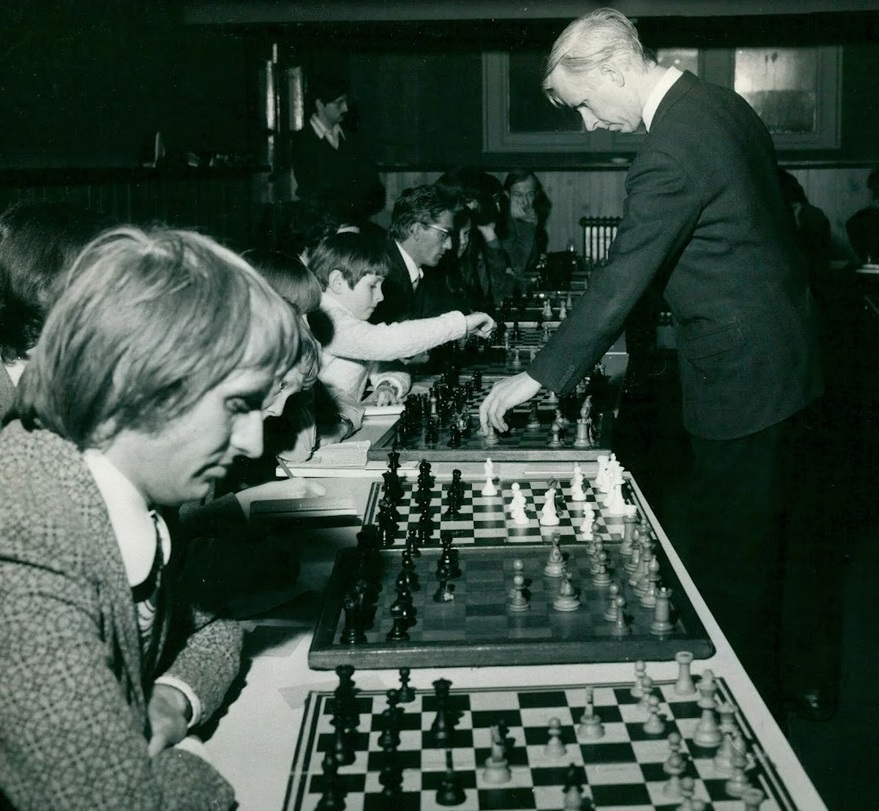
Addition on 5 June 2023:
Olimpiu G. Urcan sends a report on page 2 of the Streatham News, 11 November 1955:

Addition on 21 September 2024:
The title of ‘best chess journalist’ was awarded to Leonard Barden in the ‘FIDE 100 Awards’ in Budapest on 18 September 2024.
Addition on 28 February 2025 to our Boris Spassky feature article:
Boris Spassky died on 27 February 2025. An exceptionally fine obituary by Leonard Barden appeared in the Guardian the following day.
To the Chess Notes main page.
To the Archives for other feature articles.
Copyright: Edward Winter. All rights reserved.